News about telecommunications that would be interesting to Falkland Island consumers or businesses. I have used colour coding to prioritise news: Important – Relevant – Interesting.
![]()
I’m glad to see that a professionally run and public Request for Quote (RFQ) process is being run on St Helena.
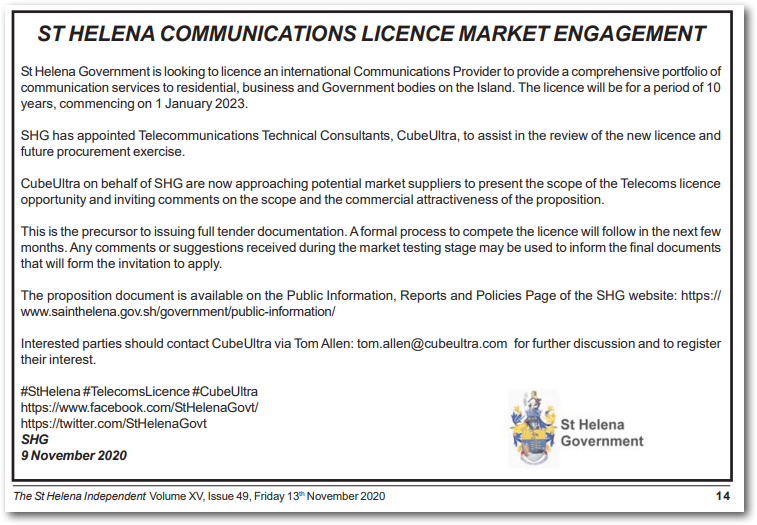
![]()
Previous news items.
![]()
![]() [expand title=”St Helena Government agrees to a communications tender process. (25-03-20)”]
[expand title=”St Helena Government agrees to a communications tender process. (25-03-20)”]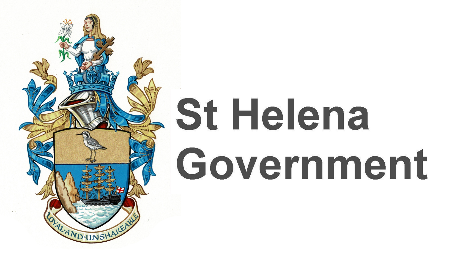
EXCO AGREES TO TENDER PROCESS FOR NEXT PUBLIC ELECTRONIC COMMUNICATION NETWORKS AND SERVICES PROVIDER/S
Executive Council (ExCo) has agreed for St Helena Government (SHG) to continue with the tender process to determine the next Public Electronic Communication Networks and Services provider/s for the Island. The current exclusive public telecommunications licence with Sure SA Ltd will come to an end on 31 December 2022.
Earlier this year SHG tested the market for new service providers through the issuing of an Expression of Interest (EOI).
SHG will now proceed with the procurement process to request proposals. Indicative timelines are that the procurement process will commence at the end of October and will be complete in the first half of 2021, with the licence agreement/s issued within the six months thereafter.
Executive Council Members were keen to engage a partner/s that will maximise the benefits of the subsea cable and the funding from the EU. Through this procurement exercise, SHG is therefore seeking to secure a provider/s that delivers the promises of the Digital Strategy and longer term economic and social development for the Island.
22 September 2020
This is an interesting stance to take in the issuing of a public tender and the considered use of the plural in “SERVICES PROVIDER/S”.
[/expand]
![]() [expand title=”Sure’s series of measures for Coronavirus (25-03-20)”]
[expand title=”Sure’s series of measures for Coronavirus (25-03-20)”]
 In response to the coronavirus situation Sure is introducing a series of measures to keep our customers in the Falkland Islands connected. These are designed to make it easier for our community to keep in touch at this unprecedented time.
In response to the coronavirus situation Sure is introducing a series of measures to keep our customers in the Falkland Islands connected. These are designed to make it easier for our community to keep in touch at this unprecedented time.
All measures are valid from 1 April 2020 for three months:
· 10% increase to inclusive broadband data allowance. This is completely free and will be applied for all customers
· 50% reduction in local-landline-to-local-landline calling charges from 6p per minute to 3p per minute
· Automatic removal of line rental charges for Old Age Pensioners
· Option for mid-month upgrades – anyone wishing to upgrade their broadband can do so during the month for no additional charges until the following full month
· Upgrading international broadband bandwidth from Friday 27 March
In addition to these consumer measures, we are working closely with the Falkland Islands Government to assist with its broadband capacity requirements.
Justin McPhee, Sure’s CEO in the Falkland Islands, said: “With many islanders now being required to work from home, self-isolating and practising social distancing to help protect the wider community we understand the importance connectivity will have to ensure we can all stay in touch and keep informed and local businesses can continue operating.
“We’ve introduced these connectivity measures to support the local community and hope these will help to make this difficult time a little bit easier.
“Everyone at Sure is working hard to ensure the island can continue to access the national critical communication infrastructure that we provide and we are in the process of adding capacity to our broadband network to meet the increased demand at this time.
“We realise that this is a worrying time and we, like everyone in our community, are paying close attention to the latest guidance from the government and the World Health Organisation – the health and safety of our employees is our top priority.
“We are here to support our island community as best we can and I’d like to thank our customers for their ongoing support and our employees for their hard work in keeping the islands connected.”
To enable the international bandwidth upgrade there will be a service outage affecting internet services and international calls between 00:01 and 01:00 on Friday 27 March.
As part of social distancing, we are currently asking that customers where ever possible, call or email us rather than visit our shops for the time being. Customers can reach our team on freephone 131 or info@sure.co.fk
[/expand]
![]() [expand title=”Snag With Linking Google’s Undersea Cable to Saint Helena Could Leave Telecom Monopoly Entrenched (22-03-2020)”]
[expand title=”Snag With Linking Google’s Undersea Cable to Saint Helena Could Leave Telecom Monopoly Entrenched (22-03-2020)”]
Source IEEE Spectrum:
Snag With Linking Google’s Undersea Cable to Saint Helena Could Leave Telecom Monopoly Entrenched
Without the planned Equiano branch, island residents won’t have access to the cable’s promised data rates
Last June, Google announced an addition to the company’s planned Equiano undersea cable. In addition to stretching down the length of Africa’s western coastline, a branch would split off to connect to the remote island of Saint Helena, part of the United Kingdom. The cable would be an incredible gain for the island of about 4,500 people, who today rely on a shared 50-megabit-per-second satellite link for Internet connections.
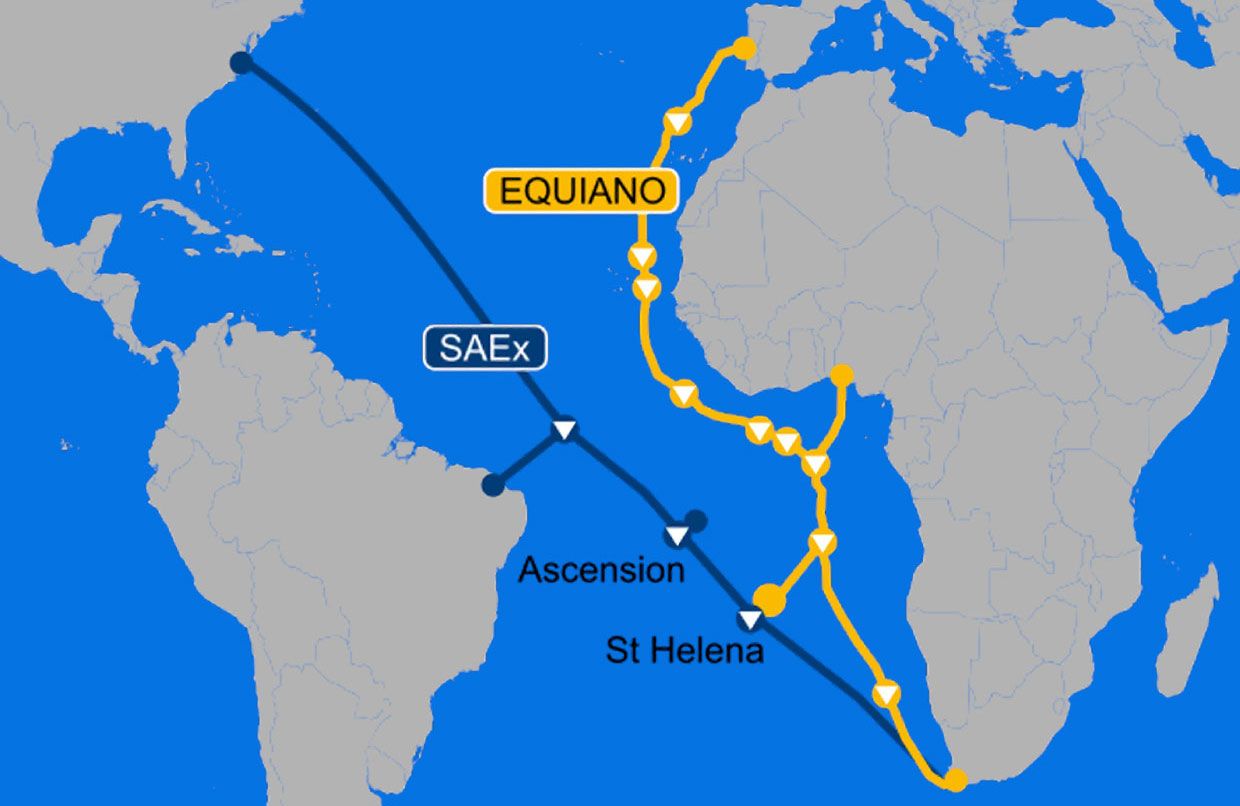
The cable will deliver an expected minimum of several hundred gigabits per second. That’s far more data than the island’s residents can use, and would in fact be prohibitively expensive for Helenians to afford. To make the cable’s costs feasible, Christian von der Ropp—who started the Connect Saint Helena campaign in 2011—worked on the possibility of getting satellite ground stations installed on the island.
These ground stations would be crucial links between the growing number of satellites in orbit and our global network infrastructure. One of the biggest problems with satellites, especially lower-orbiting ones, is that they spend significant chunks of time without a good backhaul connection—usually because they’re over an ocean or a remote area on land. The southern Atlantic, as you can surely guess, is one such spot. Saint Helena happens to be right in the middle of it.
Von der Ropp found there was interest among satellite companies to build ground stations on the island. OneWeb, Spire Global, and Laser Light have all expressed interest in building infrastructure on the island. The ground stations would be a perfect match for the cable’s throughput, taking up the bulk of the cable’s usage and effectively subsidizing the costs of high-speed access for Helenians.
But what seemed like smooth sailing for the cable has now run into another bump, however. The island government is currently at odds with the island’s telecom monopoly, Sure South Atlantic. If the dispute cannot be resolved by the time the cable lands in late 2021 or early 2022, Helenians could see incredibly fast Internet speeds come to their shores—only to go nowhere once they arrive.
“The arrival of unlimited broadband places [Sure’s] business at risk,” says von der Ropp. He points out that, in general, when broadband access becomes essentially unlimited, users move away from traditional phone and television services in favor of messaging and streaming services like Skype, WhatsApp, and Netflix. If fewer Helenians are paying for Sure’s service packages, the company may instead jack up the prices on Internet access—which Helenians would then be forced to pay.
Most pressing, however, is that the island’s infrastructure simply cannot handle the data rates the Equiano branch will deliver. Because Sure is a monopoly, the company has little incentive to upgrade or repair infrastructure in any but the direst circumstances (Sure did not respond to a request for comment for this story).
That could give satellite operators cold feet as well. Under Sure’s current contract with the island government, satellite operators would be forbidden from running their own fiber from their ground stations to the undersea cable’s terminus. They would be reliant on Sure’s existing infrastructure to make the connection.
Sure’s current monopoly contract is due to expire on December 31, 2022—about a year after the cable is due to land on the island—assuming that the Saint Helena government does not renew the contract. Given the dissatisfaction of many on the island with the quality of service, that appears to be a distinct possibility. Right now, for example, Helenians pay 82 pounds per month for 11 gigabytes of data according to Sure’s Gold Package. The moment they exceed their data cap, Sure charges them 5 pence per megabyte, which is a 670 percent increase in the cost of data.
11 GB per month may seem hard to burn through, but remember that for Helenians, that data covers everything—streaming, browsing the Internet, phone calls, and texting. For a Helenian that has exceeded their data cap, a routine 1.5 GB iPhone update could cost them an additional 75 pounds.
But it could be hard to remove Sure as a monopoly. If the island government ends the contract, Sure has a right of compensation for all assets on the island. Von der Ropp estimates that means the government would be required to compensate Sure in the ballpark of four or five million pounds. That’s an extremely hefty sum, considering the government’s total annual budget is between 10 and 20 million pounds.
“They will need cash to pay the monopoly’s ransom,” says von der Ropp, adding that it will likely be up to the United Kingdom to foot the bill. Meanwhile, the island will need to look for new providers to replace Sure, ones that will hopefully invest in upgrading the island’s deteriorating infrastructure.
There is interest in doing just that. As Councilor Cyril Leo put it in a recent speech to the island’s Legislative Council, “Corporate monopoly in St Helena cannot have the freedom to extract unregulated profits, from the fiber-optic cable enterprise, at the expense of the people of Saint Helena.” What remains to be seen is if the island can actually find a way to remove that corporate monopoly.
[/expand]
![]() [expand title=”St Helena’s Governor Rushbrook on the future of telecoms. (28-02-2020)”]
[expand title=”St Helena’s Governor Rushbrook on the future of telecoms. (28-02-2020)”]
St Helena’s Governor Rushbrook on the future of telecoms
Source: The Sentinal, Thursday 27 February 2020, pages 8 and 9.
Last week on SAMS Radio 1, during the return of Governor’s Question Time, Governor Dr Philip Rushbrook answered questions regarding the future of telecommunications on St Helena.

He answered questions about the island’s future in regard to the planned 2022 introduction of Google’s Equiano undersea fibre optic cable; whether SHG still intends to make good on its promises of faster and cheaper internet; and how SHG plans to do this.
Is SHG’s 2017 Digital Strategy, still the goal?
St Helena’s Digital Strategy was drawn up in 2017, outlining the aspects of what would be the ultimate goal for internet on St Helena. The strategy proposed connecting to a fibre optic cable to progress both business and social development on St Helena.
“We need to increase the speed and decrease the cost to consumers and businesses through accessing a marine fibre cable,” the Strategy stated.
The document went on to state that “the intention of this strategy is to provide unlimited broadband at an affordable price for the whole community.”
In last week’s interview, Governor Rushbrook described current internet prices as “painful” and said that a new package would have to be “tangibly different” post-cable.
The Governor was critical of the speed and capacity of the current service and said that there “has to be an expectation of unlimited downloads in some of the packages.”
“The quality and ability and what you can do with your internet packages from the future telecoms provider absolutely has to be materially better,” he said. “Also, it has to be cheaper.”SHG has begun negotiations with SURE for post-2022 telecommunications services (SURE’s monopoly license expires at the end of 2022), but is also seeking expressions of interest from other telecoms providers who can ensure the “cable delivers intended benefits.”
“It’s early days yet,” the Governor said. “This is going to run for quite a few more months, and of course the cable is not coming until 2022. In that sense we have some time to really get these negotiations progressed as successfully as possible.”
Regardless of what company ends up running telecommunications on the island after the introduction of the cable, the Governor said the EDF11 funding criteria will have to be met. This includes minimum internet speeds and coverage figures.
“In that sense there are some measures that the island has got to achieve,” he said. “But I think those are quite straightforward compared to the sorts of improvements the island/the Government wants to see.”
The Governor said that it was “too early days” to know what speeds and packages will actually be achieved.
He said however that he was “absolutely sure” that new packages have to be “‘different, and what is regarded by the general public as ‘better.’”
How is SHG making the island more attractive for other telecoms providers?
Historically St Helena has had trouble attracting new companies to come and operate on the island, as local telecommunications is quite an investment but the island has a very small customer base, and therefore little profit to be made. But the Governor hopes that will change post-cable.
“With the coming of a cable[… St Helena is] now a convenient part of a mix of other services,” Governor Rushbrook said. “The whole idea of the expression [of interest] is to test the market, and unless and until we get responses back, it is unclear to see what the level of interest is.”
One thing that could make St Helena a more attractive proposition for telecoms providers is the building of data centres and satellite ground stations. If a telecoms provider could make the bulk of their profit selling connectivity to data centres and ground stations, or even operating them on behalf of other companies, it would mean that they could make profit without having to inflate internet prices for the local market.
“Without doubt, if you have got more users (be it business users such as ground stations and data centres), then that’s more attractive,” the Governor said. “They can do the calculations and they can work out the income and the additional features that they can offer.”
But the Governor said this attractiveness to telecoms providers, would have to wait until the ground stations and data centres are established. He therefore described the situation as being “chicken and egg.”
[/expand]
![]() [expand title=”SHG INVITES EXPRESSIONS OF INTEREST FOR ST HELENA ELECTRONIC COMMUNICATIONS PROVIDERS. (11-02-2020)”]
[expand title=”SHG INVITES EXPRESSIONS OF INTEREST FOR ST HELENA ELECTRONIC COMMUNICATIONS PROVIDERS. (11-02-2020)”]
SHG INVITES EXPRESSIONS OF INTEREST FOR ST HELENA ELECTRONIC COMMUNICATIONS PROVIDERS.
I’m sorry about the number of posts concerning telecommunications recently (more tomorrow) but things happen quickly in St Helena. This is the way technology change should be treated.
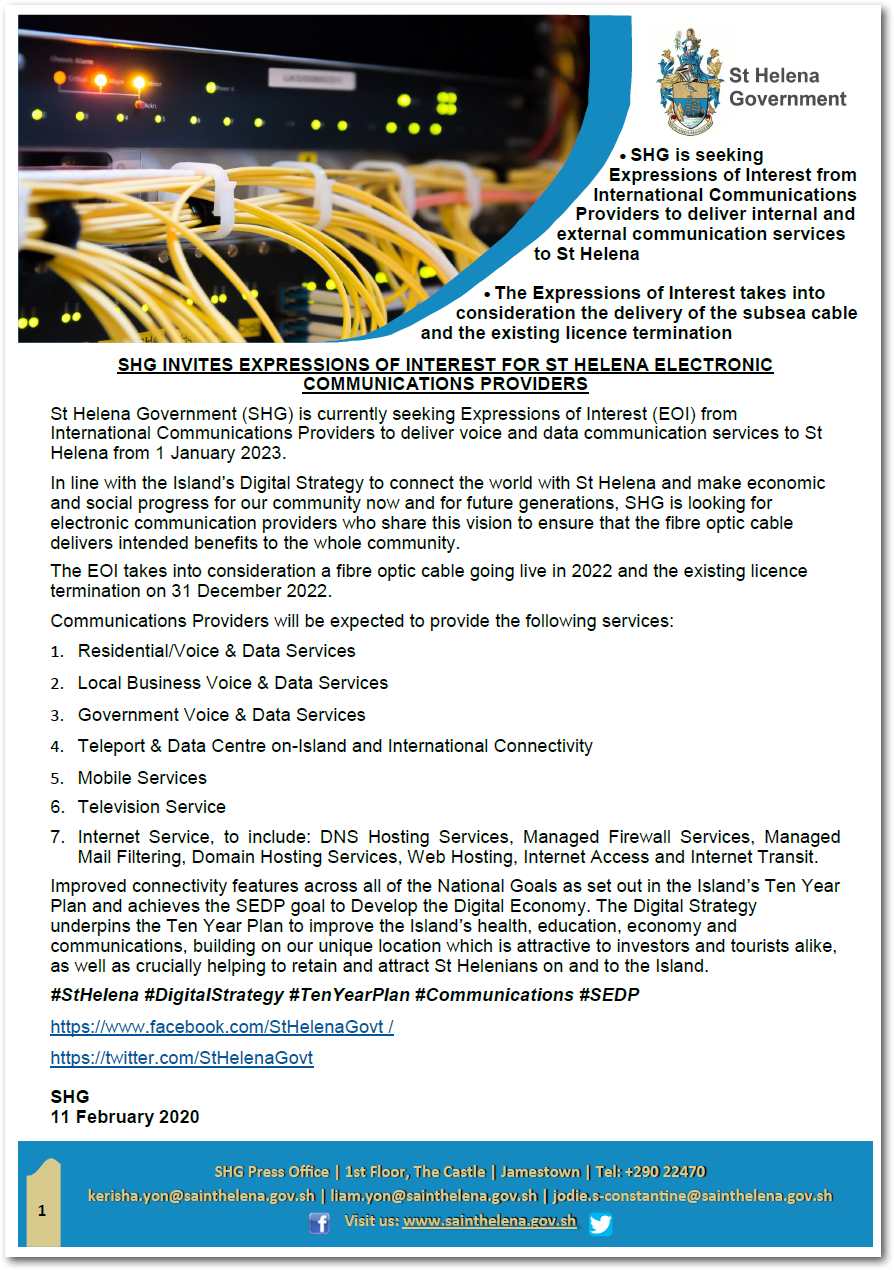
[/expand]
![]() [expand title=”Fibre optic cable for St Helena – will we get affordable high-speed Internet? (07-02-2020)”]
[expand title=”Fibre optic cable for St Helena – will we get affordable high-speed Internet? (07-02-2020)”]
St Helena Podcast.
Fibre optic cable for St Helena – will we get affordable high-speed Internet?
 This is yesterday’s St Helena Podcast of an interview with Christian von der Rupp who is the champion of the St Helena subsea cable project. He talks about the background to the project; his view of Sure’s monopoly (@21 mins); comments about Falkland Islands (@27 mins) and benefits of a fast local Internet (@39 min) and much more.
This is yesterday’s St Helena Podcast of an interview with Christian von der Rupp who is the champion of the St Helena subsea cable project. He talks about the background to the project; his view of Sure’s monopoly (@21 mins); comments about Falkland Islands (@27 mins) and benefits of a fast local Internet (@39 min) and much more.
This is an absolutely unmissable 60-minute podcast to gain an insightful 3rd-party view of telecommunications in the South Atlantic.
[/expand]
![]() [expand title=”St Helena podcast! Could Sure’s (St Helena) monopoly be coming to an end?. (27-01-2020)”]
[expand title=”St Helena podcast! Could Sure’s (St Helena) monopoly be coming to an end?. (27-01-2020)”]
SAMs podcast: SURE St Helena on the future of the island’s telecommunications – monopoly, fibre optic cable and more.
SURE CEO Christine Thomas and Networks Manager Adam Yon on Jan. 30, 2020 talked with SAMS about the future of telecommunications for St Helena Island. There are lot’s of interesting comments made that are directly relevant to Sure South Atlantic’s operation in the Falkland Islands.
[/expand]
![]() [expand title=”Sure SA Ltd Open Letter to the community of St Helena Island (24-01-2020)”]
[expand title=”Sure SA Ltd Open Letter to the community of St Helena Island (24-01-2020)”]
Sure St Helena has responded with a long letter in last week’s Sentinel.
Source: The Sentinel
Sure SA Ltd Open Letter to the community of St Helena Island
In recent times there have been newspaper articles and letters, radio interviews and various stories featured throughout social media platforms relating to the sub-sea cable’s arrival to St Helena and the future of telecommunications services to the island.
The purpose of this open letter is to give readers and our valued customers the opportunity of understanding the island’s current telecommunications service provision, the current process for the review of the Telecommunications Licence and Sure’s role in preparing the island for the arrival of the sub-sea cable.
Review of the current Telecommunications Licence
The current Telecommunications Licence is an exclusive licence granted by the St Helena Government to Sure SA Ltd and it is due to expire at the end of December 2022. It grants Sure the right to provide telecommunications services to St Helena on an exclusive basis – that is, no other company may provide such services on a commercial basis. In this respect Sure is referred to as a monopoly as there are effectively no telecommunications competitors.
This is not uncommon in small markets such as St Helena where the customer base is limited and cannot support multiple suppliers. This is especially the case with telecommunications, which requires significant and ongoing investments. Sure is a specialist provider in this respect and serves the communities of not only St Helena but also Ascension, Falkland Islands and Diego Garcia on a similar basis.
However, unlike some recent suggestions, the Licence does not grant Sure the freedom to price and deliver services as it may wish. In fact, Sure operates within strict controls which are an integral part of the Licence and these include the need for proper authorisation from the Governor in Council for any price changes. In other words, there are strong checks and balances in place within Sure’s exclusive Licence that have been agreed with the Government.
All price changes and significant changes to service must first be approved by the Electronic Communications Consultative Committee (ECCC) which is chaired by an SHG official and represented by two further SHG members. Sure has representation of two members, one of which is the current on island Chief Executive (namely myself) and the other is Sure’s Director of Legal and Regulatory Affairs. Additionally, the ECCC Chair must seek approval from the Executive Council before any decisions are made regarding telecommunications services. Therefore, despite recent suggestions, Sure is not able to make any changes to services, including pricing, without this authorisation.
The role of the ECCC is therefore a very important one and its role in regulating the industry should act as assurance to the community that the way in which Sure operates is done so in a fair manner as determined and approved by the St Helena Government and in full compliance with the obligations contained in Sure’s Licence.
The current licence renewal process, as provided for by the current licence, started during 2019 and continues into this year. At this point in time Sure remains committed to being St Helena’s telecommunications provider and is interested in providing telecommunications services beyond 2022. This has been communicated to the St Helena Government and we continue our discussions with the expectation of confirming our position within the near future.
Sure’s continued investments in St Helena
A recently published article suggested that Sure does not have any incentive to invest in St Helena due to the potential effect on the financial position of the company and the risk of not being able to pass on the cost to customers. Most commercial businesses operate on the premise that their success depends heavily on the customer base, unless their operations are being subsidised by other means, for example, through Government funding. In the case of Sure, we have invested in excess of £3 million over the past 7 years and intend to spend a further £2 million in the coming three years in order to continue enhancing telecommunications to the island. Additionally, Sure spends close to £2 million annually on the running costs associated with providing telecommunications services, which includes the costs of employing a team of 23 locally-based, skilled and professional employees who are committed to providing high quality services to our customers. We also contribute directly to the St Helena’s treasury by way of taxation.
Unlike other entities on the island which provide exclusive services, Sure does not receive any subsidy from the Government; nor does Sure receive any tax reliefs other than those available to all other companies within St Helena.
Sure has continued to invest despite the environment of a depressed economy and a decreasing customer base. The introduction of mobile phone services in 2015 is an example whereby approximately £2 million was spent, only to find that visitor numbers did not meet forecasts and have yet to reach levels sufficient to support such a significant project. Despite this, and to ensure we could meet all of our licence requirements, Sure implemented the mobile network, far surpassing the specifications of the licence despite the risk of delayed return on investment. This network also serves our sister island Ascension and demonstrates Sure’s commitment to the licence and serving the community.
Supporting St Helena in preparing for the arrival of the sub-sea cable
The new sub-sea cable is an exciting development and Sure considers its arrival at the end of 2021 as having the potential to bring about a step change not only in the economy but also in the improvement of everyone’s broadband services and connection to the rest of the world. We want to work in partnership and support SHG to realise the cable’s full potential on the economy and the community.
Today, as many readers will know, Sure connects St Helena to the rest of the world via satellite networks. Satellite networks are extremely costly and therefore there is only limited capacity and speeds that Sure can provide to our customers. The advent of sub-sea cable means that effectively the bottleneck of satellite capacity is released which enables far faster speeds to be offered.
As has been pointed out, in order to realise the full potential of the new cable, the local island broadband infrastructure may have to be upgraded further. With our investment track record in St Helena, Sure is confident that by continuing to invest in local network upgrades, the new faster speeds that the subsea cable brings would be realised. Connecting Sure’s St Helena network to the sub-sea cable has the potential to transform broadband speeds to those seen in mainland countries.
The sub-sea cable should also bring about economic development in the form of growth in the digital economy and Sure intends to work in partnership with the St Helena Government to develop opportunities such as Ground Stations operators. Sure has experience in other jurisdictions of successfully working with these types of operators and has already been meeting with a number of interested parties in St Helena.
Sure’s continued contribution to St Helena
Sure employs 23 talented, skilled and professional islanders who will continue to provide a high level of service to our customers. We will continue to contribute significantly to the island’s treasury through taxation and in investing in the local economy. We will continue to provide sponsorship and support to various events and organisations as well as the sponsorship of internet services to both Health and Education functions to support the island’s community.
We have a great desire to develop home grown talent and to that end we have and will continue to operate our own apprenticeship scheme which supports local youths on island and also gives those attending university overseas, the opportunity to observe and work in the telecommunications industry.
In summary
Whilst there has been much commentary in recent times about Sure’s current operations on St Helena and speculations as to our motives; we trust this letter outlines our current position; our motivation to improve upon our services and our desire to support the local Government and islanders in realising the benefits of the arrival of the sub-sea cable. We want to assure islanders of our commitment to our workforce and our support to the local community in meeting our Ten Year Plan National Goals; the objective of which is to ‘continue to make St Helena a wonderful place to work, live, raise children, visit and to do business’.
Whilst others may comment on what they assume to be the position of Sure and criticise our services and motives; the local community should be aware that in addition to some parties doing so from a basic rights perspective for access to Internet services for all; there are also commercial motives present which are not necessarily in the interest of St Helena.
Sure continues to be committed to serving the St Helena community, providing the island with the best possible telecommunications services and delivering on the terms of our licence agreement. Sure looks forward to both the future licence discussions in 2020 and in parallel developing a framework of partnership with SHG to fully realise the benefits that the sub-sea cable can bring to our customers and to the wider economy.
Christine Thomas
Chief Executive, Sure St Helena & Ascension Island
[/expand]
![]() [expand title=”Fibre optic cable for St Helena – will we get affordable high-speed Internet? (24-12-2019)”]
[expand title=”Fibre optic cable for St Helena – will we get affordable high-speed Internet? (24-12-2019)”]

Author: Andrew Turner, The Sentinel
The cable project, and the associated introduction of satellite ground stations, is being heralded as the next big development for St Helena.
On Christmas Eve SHG announced that a contract to connect St Helena to Google’s Equiano Subsea Cable Project had been signed and that “the target is to deliver the cable and associated high-speed internet to St Helena bar early 2022.”
Note: Of course, this is now the second undersea fibre optic cable SHG has signed up for, although the first (SAEx} suffered delays and to date still has not declared intention to proceed nor met financial close. SHG signed up for this second cable as the EDF funding that would pay for a cable would be inaccessible by the time SAEx did proceed if it does. However, SHG‘s MOU with SAEx still stands in addition to the Google cable.
SHG has said that this cable will be as important as the St Helena Airport in shaping St Helena‘s future. But some members of the community are cautious in putting too much hope into the cable project — they worry that the project, just as the Airport might not (at least in early stages deliver the amazing benefits promised.

This week, The Sentinel talked with SHG representatives as well as Christian von der Ropp from A Human Right (a non-profit organisation dedicated to providing free basic internet and phone access to developing countries}, who was one of the key campaigners for St Helena’s connection to a fibre optic cable.
This was in an attempt to better understand how the cable project might actually affect the local population on St Helena.
Will we actually get faster internet?
Well, the answer so far is both yes and no. Technically by replacing our current satellite system with a fibre optic cable, St Helena would have much faster internet access at the point where the cable reaches St Helena.
However, once the cable gets to St Helena, things could start to slow down. This is because the infrastructure on the island as of yet isn’t built to deliver faster internet to all homes on the island. Some of St Helena already is connected by fibre optic cable, but these are mostly just government offices. Otherwise, people’s homes are generally connected by copper phone lines (ADSL2+).
Christian explained how St Helenians may not see as much of a benefit as they might be expecting. “If, and to what extent, Saints will benefit from the bandwidth arriving through the cable is a very good question, “ he said. “In fact, this totally depends on SHG’s future telecoms policy.”
He explained that the island’s monopoly telecoms provider, Sure SA Ltd, currently uses ADSL2+ technology that can deliver up to 24mbps (gold plus package is advertised as getting 2.048mbps). However, this speed only reaches households close to the exchange. With increasing length of the telephone line, bandwidth quickly drops to the single Mbps range.
Christian said that in order to deliver higher speeds, the network would need to be upgraded to newer technology. “Ideally a fibre-to-the-home (FTTH) network should be rolled out to densely populated areas,“ he said. Christian said that decent data rates could, in theory, also be provided over the 4G network. But this would also require substantial upgrades, as there are not enough towers and antennas installed today to support high usage levels.
But Christian said that from an outside perspective, there would appear to be little incentive for Sure to invest in upgrading these systems, as upgrades could affect their bottom line (and costs could be passed on to consumers}.
“There’s little incentive for Sure to invest in their network and it even remains to be seen if they will fully utilize existing capabilities, as fast an unlimited broadband poses a threat to some of their existing revenue streams – particularly tee one a TV subscriptions Skype, WhatsApp, YouTube and Netflix can replace these services at little to no charge, “ he said.
Christian suggested that Sure’s monopoly on St Helena would have to end, so other companies could come in and compete, or the island to really see significantly faster cheaper internet. “Personally, I believe St Helena can only fully unlock the benefits from the cable if the telecoms monopoly is ended once the current license term ends in 2022” he said. “The local market opened for competition, as is the case in many similarly sized islands, like Montserrat. Another good example is the Cook Islands, which in anticipation of their first submarine cable (which was actually landed last month) has liberalized their telecoms market, and I believe St Helena should do the same.”
“Only under competitive conditions will Saints get fairly priced broadband with decent service quality,“ Christian said. “Also, the plan to attract satellite ground stations, and potentially further submarine cables, hinges on a friendly and lax regulatory environment.” The good news is that according to SHG, this could actually happen.
Where will we find another telecoms provider from?
Sure’s current monopoly telecommunications licence ends in 2022, and SHG said that if other companies are interested in providing a service, Sure could lose its monopoly. This in part is tied to SHG’s goals of introducing satellite ground stations to the island alongside the fibre optic cable. SHG plans to make the cable ‘pay for itself’ by allowing companies to build satellite ground stations on St Helena and then charging them to use a portion of the cable’s data stream. St Helena would then be one of the few places in the South Atlantic where companies could locate ground stations to communicate with their satellites.
According to SHG, there are already companies interested in putting ground stations on St Helena – and some of these companies are also interested in providing internet access to outlying, isolated communities across the globe, a category which St Helena would fall under.
SHG said it‘s possible that one of these companies could, as well as basing their ground station(s) locally, also provide internet to people’s homes. “We had a briefing with the last company that was here, and they certainly can provide that technology going forward,” said SHG‘s IT Manager Jerry Roberts.
Source: Andrew Turner, The St Helena Sentinel
[/expand]
![]() [expand title=”St Helena Government signs contract with Google (24-12-2019)”]
[expand title=”St Helena Government signs contract with Google (24-12-2019)”]
 Connecting to Equiano meets SHG’s timing and budgetary requirements for the European Development Fund and supports the Digital ICT Strategy for St Helena.
Connecting to Equiano meets SHG’s timing and budgetary requirements for the European Development Fund and supports the Digital ICT Strategy for St Helena.
Chairman of the Economic Development Committee, Councillor Lawson Henry, said:
“This is a huge positive step for St Helena, and one of a number of progressive steps that shall be announced over the next two years relating to development of digital opportunities on St Helena. I’d like to thank the team within St Helena Government Corporate Services, Pelagian and Keystone Law, and of course Google, for meeting this milestone.”
SHG’s Financial Secretary, Dax Richards, added:
“This is great news for the Island. Significant additional economic development on St Helena is conditional on improved connectivity and accessibility, and therefore the delivery of the Fibre Project is crucial to economic growth. We are pleased to reach an agreement with Google and look forward to working with them on this Project.
“The delivery of the Fibre Project is a key action in the Sustainable Economic Development Plan – in order to develop the satellite ground stations, financial services, work from home, academia research and conferences, film location and tourism sectors.”
Global Network Infrastructure Strategy, Submarine, Google, Jayne Stowell, concluded:
“We are excited to collaborate with SHG to announce the Equiano branch into St Helena. We are deeply committed to boosting the world’s connectivity as well as ensuring countries and communities benefit from the Equiano cable.”
The branch between the main trunk of the Equiano cable and the Island will be 1140km long. The target is to deliver the cable and associated high speed internet to St Helena by early 2022; providing the cable laying, landing station and associated planning permissions and works to start the service proceed on time.
This cable will be capable of providing the Island with scalable connectivity, ranging from a few hundred gigabits up to multiple terabits, as demand varies. On that basis it allows for the most cost effective growth of bandwidth needs for the Island.
Source: Connect St Helena
[/expand]
![]() [expand title=” A local company, Seychellois group, buys Seychelles’ Cable & Wireless. (07-11-2019)”]
[expand title=” A local company, Seychellois group, buys Seychelles’ Cable & Wireless. (07-11-2019)”]
OpenFalklands: This is the sale of one of the remnants of the global Cable & Wireless global telecommunications empire. Many remote islands were bought by Sure International, others by Liberty America.
C&W Seychelles has now been bought out by a number of Entrepreneurs who live in the islands.

In existence for over 125 years, Cable & Wireless (Seychelles) Ltd (CWS) has announced that it is now 100% owned by a group of well-known Seychellois entrepreneurs.
Following months of planning and negotiations, the new shareholding group purchased Cable & Wireless Seychelles (CWS from Liberty Latin America in a transaction costing in excess of US $130 million, including the consideration price and acquisition costs.
The new owners, under the formation of CWS Investment Ltd, include the JFA Group, Jamshed Pardiwalla, Ravji Raghwani and Andy Bainbridge, as well as Victoria-based professional services firm ACM, which represented the shareholders in the deal.
According to ACM Senior Partner Oliver Bastienne, the deal was an unprecedented opportunity to bring one of Seychelles’ biggest companies into local hands.
“For a group of Seychellois to piece together an acquisition of this scale from a global multi-national company is a tremendous achievement,” Mr Bastienne said. “We expect this to have a positive impact for all involved, from CWS staff, to the customers, and the country as a whole.”
The acquisition was financed by a consortium of banks led by Trade Development Bank (TDB), with the participation of Barclays and ABC Banking Corporation of Mauritius. Nouvobanq has also been instrumental in facilitating the purchase, Mr Bastienne said.
CWS employees were informed of the acquisition as soon as it was formally announced. Mr Bastienne affirmed that there is no re-structuring planned, that day-to-day operations would not be affected and no employees would be made redundant.
“CWS is a successful company and the new owners have placed an emphasis on business continuity and growth,” Mr Bastienne said. “The CWS team will stay on with the new shareholders’ backing to further strengthen the company’s commercial position.”
In the coming months, the new board will be studying opportunities for long-term growth and development from the perspective of a Seychellois-owned company, benefitting customers, staff and Seychelles at large.
“The new shareholders want to invest for long-term growth and this will directly benefit the Seychelles economy in a number of ways,” Mr Bastienne said.
CWS Chief Executive Charles Hammond, who will continue in his role under the new ownership, expressed confidence that CWS has the potential to become a more agile and responsive company.
“There will be a number of new opportunities under the direction of local ownership that understands the market well.” Mr Hammond said. “I am looking forward to continue driving the business forward in a new chapter that I believe our employees and customers will embrace.”
Source: C&W Seychelles
[/expand]
![]() [expand title=” A clear signal of Sure’s commitment to Guernsey (17-10-19)”]
[expand title=” A clear signal of Sure’s commitment to Guernsey (17-10-19)”]
Did you know that Guernsey is connected to the rest of the Channel Islands, the UK, Europe and the world by a vast subsea cable network?

The first phase of this plan is to upgrade the subsea cables that link us to the rest of the world and provide the majority of the island’s communications needs including broadband, voice and data services.
Safeguarding the island’s future
Upgrades to the subsea cables will increase Sure’s network capacity to 300 Gigabits per second, an increase of almost 300%, to meet the island’s future bandwidth needs for the next five years. This new network makes it much easier to upgrade at increments of 100 Gigabits; an increase of more than ten times over the technology currently deployed.
Demand for data, which is increasing by 35% each year, is being fuelled by a range of digital applications such as Netflix or Sky 4K HD video streaming, Amazon Prime’s live Premier League football streaming and services such as Google’s soon-to-launch Stadia streaming gaming service. For business customers their digital transformation activities and increasing uptake of cloud technologies are driving demand for moving more data in and out of Guernsey.
The importance of our subsea infrastructure really can’t be overstated. Guernsey has been winning business on the world stage as a direct result of our network resilience and, of course, it keeps all of us connected in our daily lives. It is the unseen foundation that enables and secures connectivity for businesses, in our homes and when mobile.
We’re carrying out this upgrade work, which is a significant multimillion-pound investment, to reinforce the quality of the infrastructure and ensure that our network continues to be the most resilient in the Channel Islands.
An ambitious plan
The subsea cable upgrade is just the first step in our five-year investment plan for Guernsey, which will significantly enhance residential broadband and business connectivity.
We are investing in a range of new broadband technologies to stay ahead of customer demands as consumers and businesses increasingly use digital services. The plans include a commitment to increasing broadband speeds through extending our fibre-rich approach and new innovations including trials for fibre directly to the home and 5G services, both of which will commence in the coming months.
We’re proud to run our global business from Guernsey and believe in the island’s future. This plan is a clear signal of our commitment to the island, its economy and its people.
We’ll be making more announcements in the coming months about our five-year investment plan and the implications for the digital future of the Bailiwick, so stay tuned to our social media channels to learn more about the future of the island’s connectivity.
Source: LinkedIn
[/expand]
![]() [expand title=” Guernsey ISP Sure Prep 300Gbps Upgrade of Subsea Network (17-010-19)”]
[expand title=” Guernsey ISP Sure Prep 300Gbps Upgrade of Subsea Network (17-010-19)”]
The incumbent broadband, 4G mobile and phone provider on the English Channel Island of Guernsey, Sure, has announced a major 5-year plan to invest several million pounds in order to upgrade their sub-sea fibre optic links with the United Kingdom. This could increase network capacity to 300Gbps (Gigabits per second).
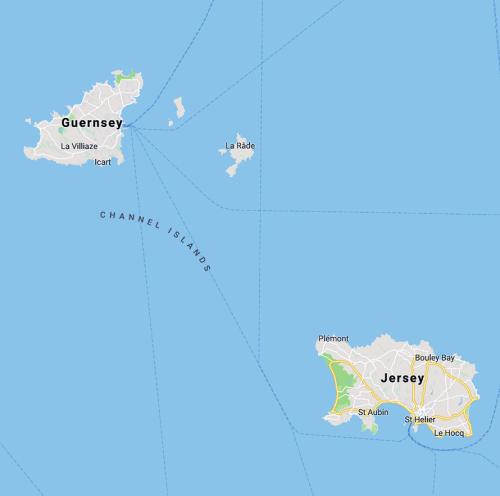
The incumbent broadband, 4G mobile and phone provider on the English Channel Island of Guernsey, Sure, has announced a major 5-year plan to invest several million pounds in order to upgrade their sub-sea fibre optic links with the United Kingdom. This could increase network capacity to 300Gbps (Gigabits per second).
At present most fixed broadband connections on the island are delivered by a Fibre-to-the-Cabinet (FTTC / VDSL) network that is capable of speeds up to 100Mbps, although this is expected to be improved with the future introduction of Very High bit rate Digital Subscriber Line (VHDSL) technology. Some Fibre-to-the-Premises (FTTP) infrastructure is also present on parts of the island.
Last year the States of Guernsey (Government) set out a new strategy to help bring FTTC/P to business districts, support the rollout of ultrafast 5G mobile technology and ensure that 85% of homes can access broadband speeds of up to 100Mbps (public money was proposed to help fix the final 15% but the details of this remain unclear).
Suffice to say that all of the above, when combined with rising data demands from local consumers, means that operators like Sure and JT on Guernsey will need more capacity. Both JT and Sure already have multiple links on the island, most of which connect to the UK and one goes back through Jersey and then on to France (INGRID / Channel Islands Electricity Grid).
We should point out that both CI-4 and CI-7 have an estimated lifespan of 25 years and they’ll actually be reaching the end of their predicted life this year, which is important because Sure doesn’t say precisely which of their subsea cables are going to be upgraded to deliver this 300% capacity increase or how. Sure could conceivably extend the lifespan of those cables by adding new repeaters to tackle loss, but they might also build a new cable.
Ian Kelly, Sure CEO, said (Guernsey Press):
“The importance of our subsea infrastructure really can’t be overstated. Guernsey has been winning business on the world stage as a direct result of our network resilience and of course it keeps all of us connected in our daily lives. It is the unseen foundation that enables and secures connectivity for businesses, in our homes and when mobile.
We’re carrying out this upgrade work, which is a significant multi-million pound investment, to reinforce the quality of the infrastructure and ensure that our network continues to be the most resilient in the Channel Islands. The digital future and this investment are aligned with the States of Guernsey’s ambitious telecoms strategy as we work together to secure the island’s continued prosperity and success.”
You can read the local Government’s Digital Strategy (PDF) for a bit more background to why Sure are making this change. Sure also appear to be considering the idea of using their future 5G network to reach homes with ultrafast broadband, rather than further extending their fixed line FTTC/P.
Sure currently owns 100% of fixed line services to consumer households and has the ability to connect most businesses and Government departments to fibreSure, which has over 400km of fibre in the ground and typically spends in the region of £1m a year on extending the reach of this network.
Source: ISP Preview
[/expand]
![]() [expand title=” Kleiner Perkins Internet Trends Report 2018 (17-08-19)”]
[expand title=” Kleiner Perkins Internet Trends Report 2018 (17-08-19)”]
[Ed:] Is the Internet now the most important utility for sustained business growth and social satisfaction?
At 3.6B, the number of Internet users has surpassed half the world’s population. When markets reach the mainstream, new growth gets harder to find -evinced by 0% new smartphone unit shipment growth in 2017.
We focus on trends around data + personalization; high relative levels of tech company R&D + Capex Spending; E-Commerce innovation + revenue acceleration; ways in which the Internet is helping consumers contain expenses + drive income (via on-demand work) + find learning opportunities. We review the consumerization of enterprise software and, lastly, we focus on China’s rising intensity & leadership in Internet-related markets.
See the whole PowerPoint report here.
[/expand]
![]() [expand title=”CABLE SURVEY SHIP COMES TO ST HELENA (14-08-19)”]
[expand title=”CABLE SURVEY SHIP COMES TO ST HELENA (14-08-19)”]
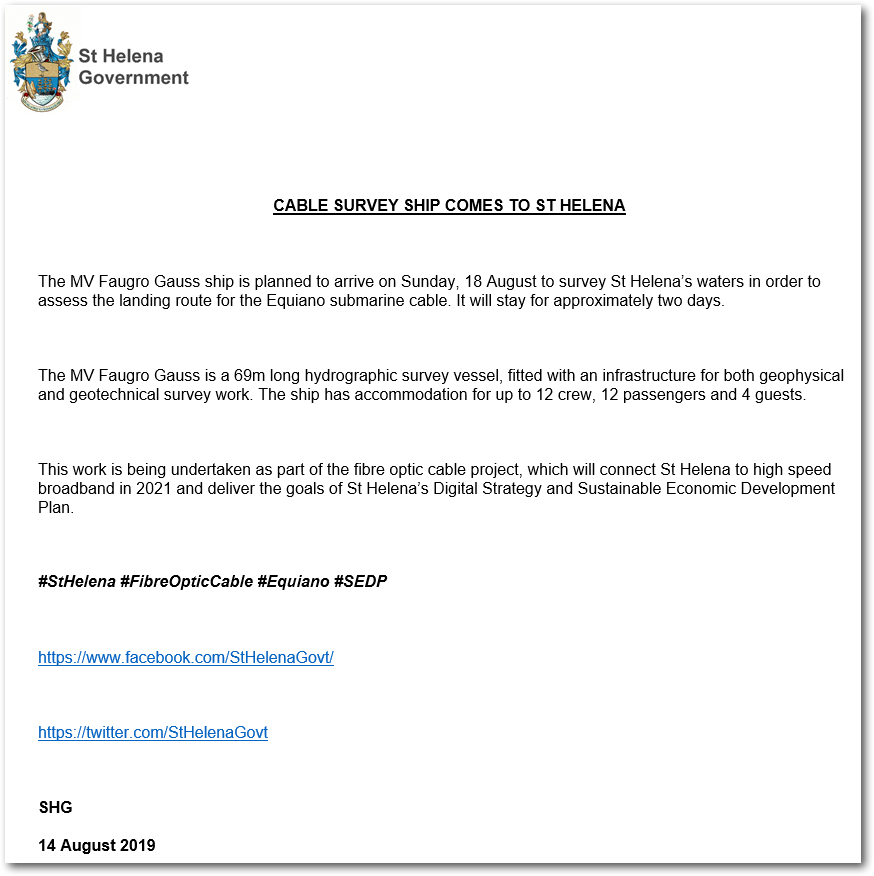
[/expand]
![]() [expand title=”Orkney 5G trials could soon be a reality (03-08-19)”]
[expand title=”Orkney 5G trials could soon be a reality (03-08-19)”]
5G networks are starting to pop up in UK cities – but for many rural areas even getting a basic mobile signal remains a challenge.
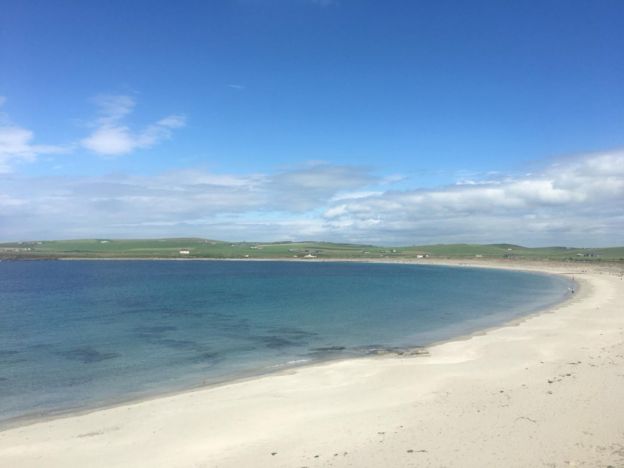 Photo credit BBC News.
Photo credit BBC News.
This was certainly the case in the Orkney Islands, an archipelago of 70 islands off the north coast of Scotland.
Its population of 22,000 is spread across 20 of these islands and has consistently ranked as one of the most under-connected in the country.
But this could be about to change.
A lot more about the benefits to farming and fishing and other Orkneys businesses can be found here https://www.bbc.co.uk/news/technology-49191654
[/expand]
![]() [expand title=”Huge step forward for St Helena’s connectivity today! (19-07-19)”]
[expand title=”Huge step forward for St Helena’s connectivity today! (19-07-19)”]
Excellent news!
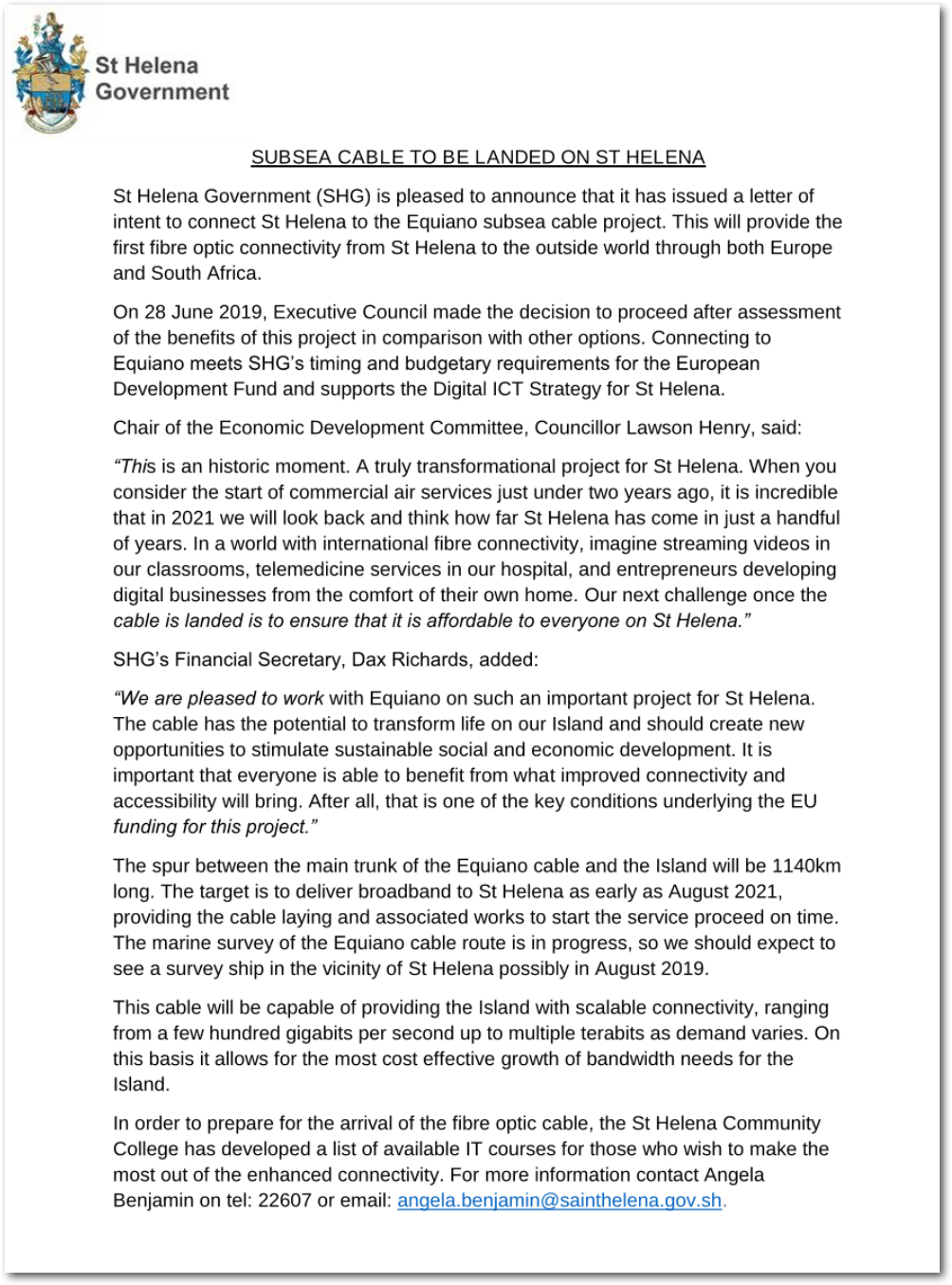
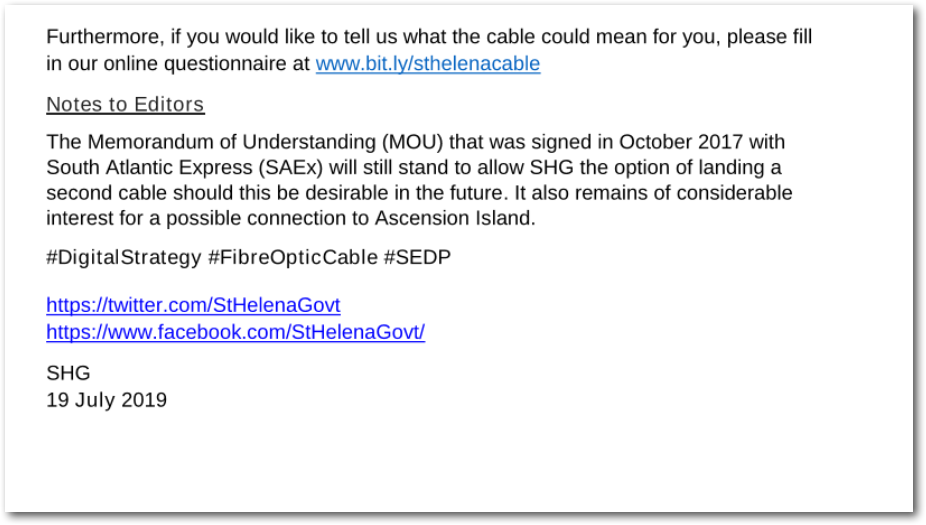
[/expand]
![]() [expand title=”Agreement close on St Helena link to Google’s Equiano Cable? (12-07-19)”]
[expand title=”Agreement close on St Helena link to Google’s Equiano Cable? (12-07-19)”]
A new route to achieving a connection to the global fibre-optic cable network appears to be moving fast to completion. The Independent reported last week that Google officially announced the go-ahead for their Equiano cable from Portugal to Cape Town. The cable has several branching points built into it; one is located as the cable passes about midway between St Helena and Angola. Google made their announcement twelve days ago. Nine days ago SHG’s Financial Secretary and Chief Economist said they felt confident and comfortable arrangements for the cable connection would be finalised soon.
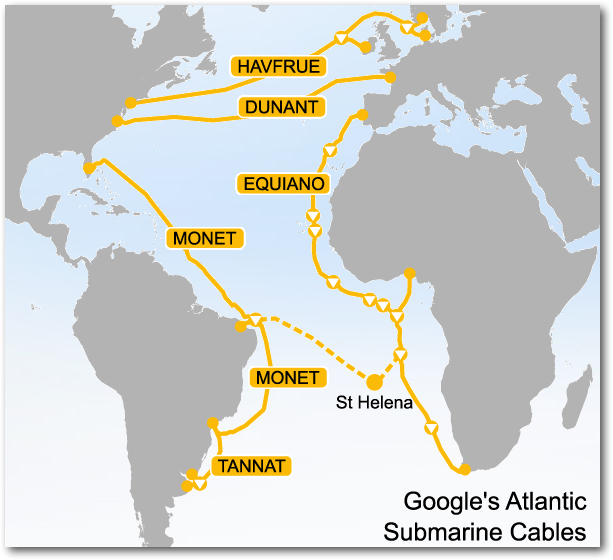
Six days ago, (last Saturday) both the Financial Secretary and the Head of IT, Jerry Roberts, flew overseas; Dax Richards was travelling on business but the purpose of that business has never been officially announced. Frequent enquiries asking where they have gone and what they are doing resulted in one short and probably rushed email from the Financial Secretary. Dax said, “I have had a very productive week so far, of course I can’t discuss the details but I think by just having a presence at this event has made a lot of people in the industry sit up and take notice. There are other potential future options for increasing economic activity on the Island once a cable is landed as you know, and we should explore these in more detail over the coming months. Happy to discuss when I get back.”
To see more, please go to ConnectStHelena website.
Source: Originally published in the St Helena Independent, Vol. XIV, Issue 32, Friday 12th July 2019, p.2
[/expand]
![]() [expand title=”Communications Regulator job posted (10-07-19)”]
[expand title=”Communications Regulator job posted (10-07-19)”]
Do you have the skills to be the Communications Regulator for the Falkland Islands? Are you looking for a lifestyle change and a new challenge which offers a once in a lifetime experience? How about living within a thriving community, set in a stunning natural environment? If so, this job is for you.
The Role
This is an exciting opportunity to lead the regulation of communications services in the Falkland Islands. We are looking for a senior individual with the ability to apply regulatory principles in a monopoly environment, while tailoring their approach for the unique characteristics of this role.
The core purpose of the role is to ensure effective regulation of commercial telecommunications services in the Falkland Islands. In particular, to ensure that the exclusive licensee is compliant with the conditions of their operating licence: including service levels in accordance with defined performance indicators; and implementation of major improvements.
The Person
The successful candidate will have at least ten years’ relevant professional experience: gained in either a national regulator; the telecommunications industry; a suitable consulting field, or have the necessary transferrable skills to meet the requirements of the role. Strong influencing skills are needed and the ability to establish credibility with a range of senior stakeholders. The role comes with a number of statutory powers (including arbitration of complaints and the determination of penalties should licensees fail to meet their obligations). You will be able to work independently and be highly self-motivated as this is a standalone role.
The Package
- Initial 2 Years Fixed Term Contract, with potential for extension by mutual agreement.
- Salary Range £41-56k, inclusive of the 25% Gratuity. Starting salaries will be dependent upon qualifications and experience.
- 30 Days Annual Leave, plus government and public holidays (totalling 41 days leave).
- Relocation Allowance, to help with moving costs.
- Flights Package for you and your dependents, including mid-term return flight home.
- Government Housing for rent at a subsidised rate and a starter pack to help you settle in.
How to Apply
For more information and to apply online to join our team in a unique and breath-taking location, with penguins, dolphins and the wilderness just next door to your office, please visit our new recruitment website: https://ats-fig.jgp.co.uk/vacancies/view/103701
Applications close at 23.00 UK time on 31 July 2019.
If you have any questions about working for the Falkland Islands Government or would like further information about applying, you can find contact details at the above link.
Falkland Islands Government (FIG)
The Falkland Islands is a British Overseas Territory, with full internal self-government.
As the largest employer in the Falkland Islands, we offer many unique and fulfilling job opportunities, across the full spectrum of public services. Our responsibilities include those typically managed by central government – taxation, legislation and policy, as well as those usually managed on a local level such as town planning, health and social services, and education. FIG also provides services specific to the needs of the Falkland Islands, such as fisheries research, power generation and the Government Air Service, FIGAS.
For more information about working for Falkland Islands Government, take a look at our recruitment microsite: www.jobs.gov.fk
The Falkland Islands
Set in the South Atlantic Ocean, around 400 miles east of South America and 8000 miles south-west of the UK, the Falkland Islands are a small, thriving community with a British way of life, benefiting from good local services, a varied social calendar and an absence of traffic jams!
The Falkland Islands’ stunning natural environment provides an unspoiled landscape and amazing wildlife to observe and explore, including penguins, whales and dolphins, all seen from the shore.
For those with a sense of adventure, it provides opportunities which are hard to match anywhere else in the world.
Further information on this vacancy
Source: FIG website
[/expand]
![]() [expand title=”Updated comment about St Helena’s SAeX and possible FI submarine cable (14-06-19)”] Update: Google’s new Equiano Africa cable.
[expand title=”Updated comment about St Helena’s SAeX and possible FI submarine cable (14-06-19)”] Update: Google’s new Equiano Africa cable.
Update: 1st July 2019
Google has announced it’s third subsea cable will pump data from Portugal to South Africa.
“Google’s third undersea network cable will shuttle high-speed data from Portugal to South Africa and countries in between starting in 2021, a fiber-optic line called Equiano. The fiber-optic line is part of Google’s massive investment in computing infrastructure — an investment that reached $47 billion over the last three years, Google said in a blog post Friday.”
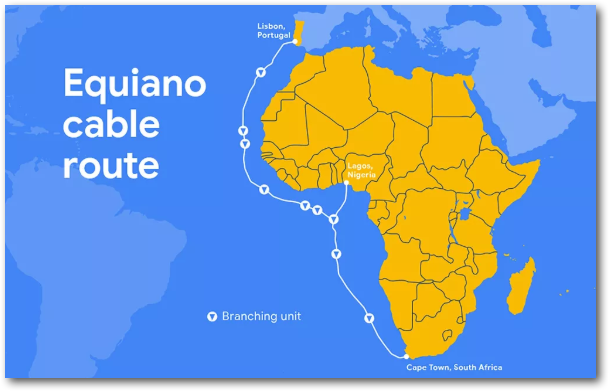
The Canary Islands have already signed an Agreement with Google to explore the possibility of landing a cable in the Canary Islands.
![]()
Below is a final paragraph extracted from an article about a possible Arctic submarine cable. I wrote about the St Helena SAeX submarine cable in the OpenFalklands post – St Helena’s submarine cable. It’s not looking too good I’m afraid as the paragraph does accurately reflect the current view in the submarine cable industry.
“Of course, not all cable projects succeed. The South Atlantic Express (SAex), would be one of the first direct links between Africa and South America, and connect remote islands like St. Helena along the way. But SAex has struggled with funding and currently sits in limbo. Cinia and MegaFon [Arctic cable] hope to avoid a similar fate.”
Source: IEEE Spectrum
I have also written about the Chilean cable going to Tierra del Fuego in Fibra Optica Austral; Chile’s cable to Tierra del Fuego which is the nearest cable to the Falkland Islands. The build of which is going well.
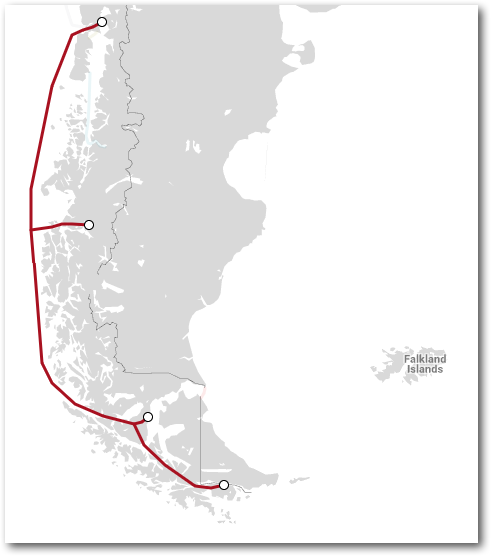 It’s interesting to note that the possibility of a submarine cable to the Falkland Islands is included in the ‘National Broadband Strategy’ announced in the March 2019 Communications Week and mentioned several times on Facebook since.
It’s interesting to note that the possibility of a submarine cable to the Falkland Islands is included in the ‘National Broadband Strategy’ announced in the March 2019 Communications Week and mentioned several times on Facebook since.
I think it’s good that the favourite politician’s phrase is in use here – “Nothing is ruled out and nothing is ruled in”. However, for all the reasons discussed in my post, there is just no possibility of a submarine cable being laid to the Falkland Islands. It is too costly from a capital expenditure and on-going operational / repair cost perspective, 100% of which will need to be paid by the Falkland Islands Government. (Picture: Telegeography)
At a major submarine cable conference earlier this year that I attended, there was an explicit view stated in several presentations and in one-to-one discussions, that no new submarine can be successfully financed these days unless Google or Facebook are highly involved. This is probably the issue that lies behind the St Helena SAeX cable problem. Everyone politely smiled when I talked about a cable to the Falkland Islands.
Another common phrase would be that “I would eat my hat” if there was the slightest possibility of such a submarine cable solution for the Falkland Islands, but I don’t have a hat., so… Instead, I will put “my money where my mouth is” and propose that I will place money behind a Stanley pub bar one evening instead if a cable is proposed for the Falkland Islands. I am not optimistic, but I look forward to buying lots of drinks. ![]()
[/expand]
![]() [expand title=”Sure Falkland Islands allows multiple Internet top-up packages (12-06-19)”]
[expand title=”Sure Falkland Islands allows multiple Internet top-up packages (12-06-19)”]
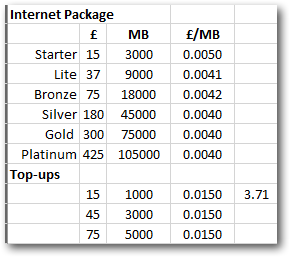 It’s good to see that ‘consumer feedback’ has been listened to to correct the original single top-up negotiated by FIG and agreed with Sure Falkland Islands. It was always a nonsense that multiple top-ups were not available in the first place as that was only sensible for all parties I would have thought?
It’s good to see that ‘consumer feedback’ has been listened to to correct the original single top-up negotiated by FIG and agreed with Sure Falkland Islands. It was always a nonsense that multiple top-ups were not available in the first place as that was only sensible for all parties I would have thought?
What business in the world would not want additional revenue?
It’s easy to say that KPI obligations have been met – and that is good I guess – but what is more important is what the KPI delivers and at what cost. What has not been explained are the reasons behind making top-ups a whopping 3.71 times the cost of any of the standard monthly Internet packages.
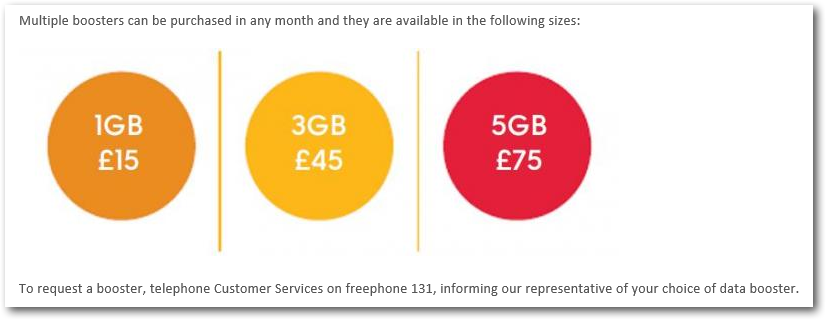
Clearly, there was some reasoning behind the pricing that has been agreed to by FIG and the Regulator unless it was a ‘take-it-or-leave-it’ offer by Sure Falkland Islands? This price will now become the benchmark price for price-capping going forward so at least consumers know prices will not rise beyond RPI in coming years.
So what reasons could be conjectured for there to be a 3.71x mark-up?
1) It’s another way to recoup some of the lost revenue caused by removing overage charges?
2) Does it cover the cost of administrating top-ups?
3) Sure do not want extra IP traffic on the network, so the price hike acts as a major financial disincentive to buy top-ups?
I hope it’s not the first, but with no public explanation, this just leads to numerous conspiracy theories being broached as seen on Facebook. Why is this allowed to occur as it seems to happen time and time again? The provided explanation may be factual or ‘economical with the truth’ but the justification of a 3.71x mark-up should be demanded forthwith.
However, there really should be no need for it to be demanded. In a modern open society, this should have been offered as it was obvious what the consumer reaction would be. Come on MLAs, FIG, Regulator and even Sure Falkland Islands – step up to the mark and provide that missing justification. It should not be a secret and it’s certainly should not be considered ‘commercially confidential’.
[/expand]
![]() [expand title=”Spare a Thought for the Falkland Islands and Terrible Broadband. (05-06-19)”]
[expand title=”Spare a Thought for the Falkland Islands and Terrible Broadband. (05-06-19)”]
We often report in gripes with rural broadband connectivity from across the United Kingdom but spare a thought for the 3,400 people living on the largely self-governing and self-sufficient Falkland Islands, where all of the fixed line services and mobile networks are still supplied by a limited Satellite data link.
The islands, which are an Overseas Territory of the UK that reside nearly 500 kilometres off the South American coast (Argentina), have long suffered from poor digital connectivity and that’s partly due to the political fallout from the 1982 Falklands War (running a link back through Argentina, where the islands are known as Islas Malvinas, probably isn’t going to be considered either viable or wise any time soon).
On top of that, the community is also incredibly remote, which even in an ideal political environment would still make running a subsea fibre optic line incredibly expensive (the islands GDP is £100m per annum and it’d probably cost more than that). Likewise, you’d struggle to get a viable fixed wireless link from the South American coast.
Instead, the islands are forced to get their data capacity from a Satellite link, which we believe currently leases about 200-300Mbps of total capacity. Little wonder that the average broadband download speed recorded by users on the Falkland Islands is around 1.5Mbps, with uploads coming in at just below 1Mbps (note: the speedtest sample size for this is tiny but the results seem about right given the above figures).
Fixed line ADSL broadband services on the islands tend to be provided by Sure (Sure South Atlantic), while Mobile comes from Vodafone. The latter has recently deployed a 4G network, which seems able to deliver the ever so slightly better average download speed of around 2Mbps (hardly worth using 4G for that but then the kit had to be upgraded anyway).
Sure tends to offer a choice of capped broadband packages, which range from 1.28Mbps (0.12Mbps upload) with a 3GB usage allowance for £15 per month to 5Mbps (0.76Mbps) with 105GB for £425.00 per month! Yes, we can confidently classify this level of connectivity as being.. crap. However, there are hints of progress from the local Government.
Governor Nigel Phillips, Speaking to the Falkland Islands Legislative Assembly, said yesterday:
“This year has also seen advancements in telecommunications with the introduction of increased broadband allowances in July 2018 as well as the rollout of a new 4G network and the extension of the existing 2G network to remote areas.
The Government continues to work with the monopoly provider to help measure performance and target future investments.
Furthermore, the Regulator has been working hard to put in place plans to improve telecommunications services which remain a challenge for the islands. This has included the introduction of a new Spectrum Management Framework and the development of a new National Broadband Strategy.”
Unfortunately that National Broadband Strategy is somewhat hobbled by the fact that all it can really do is put forward a case for increasing Satellite capacity. On the upside, it’s just possible that one of the new Low Earth Orbit (LEO) based satellite constellations, such as from SpaceX (here) or OneWeb (here), might end up providing a good solution but we won’t know for sure until those reach commercial operation. In any case, the local government has not yet considered this.
Source: ISP Review
[/expand]
![]() [expand title=”4G vs 5G: what’s the difference? (23-05-19)”]
[expand title=”4G vs 5G: what’s the difference? (23-05-19)”]
5G is making its way to the UK, but it’s not the end for 4G! 4G is still the bedrock of our network, connecting people to the services they need and love, right across the UK. Every day, we’re building new 4G sites in rural parts of the UK, giving communities a digital connection for the first time.
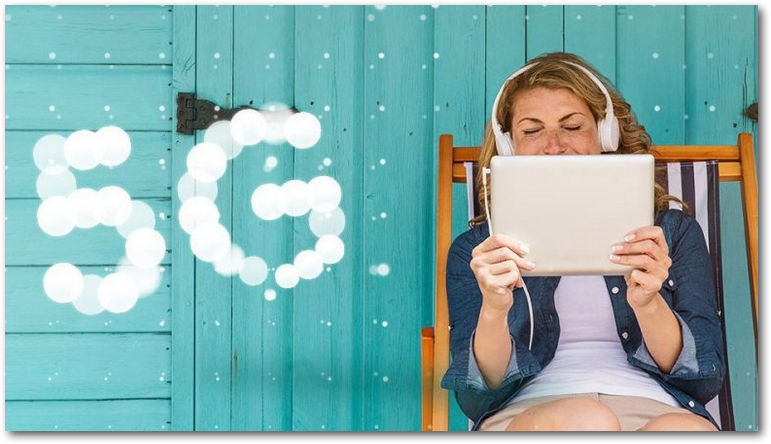
Unlike 3G to 4G, 5G is not a replacement for 4G. It adds another layer to the network to provide more capacity in the busiest parts of the UK’s busiest cities.
Let’s look at how 4G and 5G will work together.
When 4G first arrived on our phones in 2012 it was revolutionary. It’s shaped how people across the UK communicate, watch, learn and share.
5G will build on that.
Adding 5G to the UK’s number one 4G network will increase reliability and keep people connected where they need it most, in the busiest places. 5G will offer customers increased speeds, more reliable coverage and reduced latency. This will mean faster downloads of your favourite films and albums, quicker website browsing, and a better streaming experience in busy areas.
5G has the potential to give customers 1Gbps speeds to their smartphones – that’s an incredible milestone to reach. And it can reduce latency from 30-40ms today, to as low as 10ms in the future.
And 5G will work hand-in-hand with 4G: when you connect to 5G on EE, you’re actually connecting to both the 4G and 5G parts of the network at the same time, and you get the combined power of all that 4G and 5G capacity.
5G isn’t a replacement for 4G – it’s an addition to our existing award-winning network.
Our 5G roll out will start with the busiest locations in the busiest cities where it can make the biggest difference to the most people.
You’ll need a new phone to use 5G. Expect 5G-enabled devices to appear this summer – Samsung has already announced they’re due to bring their Galaxy S10 5G to the market in 2019, and we’ll be ranging the OnePlus 5G smartphone on our network.
It’s time to get excited about the possibilities of 5G, but don’t forget the importance of a great 4G network to enable those possibilities and keep you connected everywhere you go.
Source: EE
[/expand]
![]() [expand title=”Mobile data pricing in 230 countries: Falklands are #227.(21-05-19)”]
[expand title=”Mobile data pricing in 230 countries: Falklands are #227.(21-05-19)”]
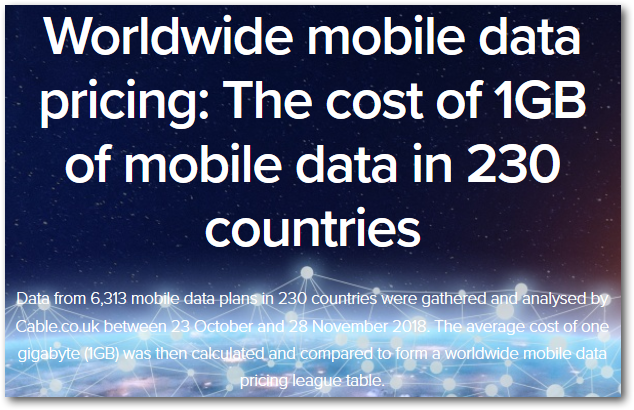

According to this survey, the only countries taht are more expensive than the Falkland Islands are St Helena, Equatorial Guinea and Zimbabwe.
“At the more expensive end of the list, we have countries where often the infrastructure isn’t great but also where consumption is very small. People often buy data packages of just tens of megabytes at a time, making a gigabyte a relatively large and therefore expensive amount of data to buy. Many countries in the middle of the list have good infrastructure and competitive mobile markets, and while their prices aren’t among the cheapest in the world they wouldn’t necessarily be considered expensive by their consumers.”
The full table and details may be found here: Cable.co.uk
[/expand]
![]() [expand title=”Sure doubles 4G network speeds in St Peter Port (20-05-19)”]
[expand title=”Sure doubles 4G network speeds in St Peter Port (20-05-19)”]
Mobile data speeds in St Peter Port have doubled as a result of Sure’s continued investment in the network and commitment to equipping the island with the latest digital technology.
The telecoms company has installed new mobile technology on its main base station in St Peter Port as it continues to prepare for the future roll out of a next generation 5G network. The site, above the Odeon car park, has been upgraded to provide faster data speeds and the ability to handle additional capacity. The new technology will provide data speeds of over 400Mbps on compatible mobile devices such as the Apple iPhone XS or recent Samsung Galaxy handsets.
“Mobile data usage is increasing all the time and we’re constantly rolling out the latest solutions to stay ahead of demand and give our customers the best possible experience. This latest work will make the network even faster and improve customers’ browsing, streaming and downloading.” said Steve Ozanne, head of mobile at Sure.
“This enhancement is part of our continual mobile network investment programme and marks an important step on the evolution from a 4G network to a ubiquitous 5G network within the Bailiwick, which will give islanders a ‘fibre in the air’ experience.
“We are committed to supporting the island’s increasingly digital future and our investment programme is aligned with the States of Guernsey’s progressive and ambitious Future of Telecoms policy.”
As well as upgrading St Peter Port, additional investment has taken place across the Bailiwick. Residents in Alderney and Sark will now benefit from superior indoor 4G coverage and increased download speeds thanks to new deployments on each island. Upgrades have also been completed at Jerbourg, which will improve coverage and data speeds for customers in the area.
Source: Sure Guernsey

“This latest work will make the network even faster and improve customers’ browsing, streaming and downloading. This enhancement is part of our continual mobile network investment programme and marks an important step on the evolution from a 4G network to a ubiquitous 5G network within the Bailiwick, which will give islanders a “fibre in the air” experience”. Steve Ozanne, Head of mobile at Sure
Source: BBC (I won’t provide a link as the post will disappear within a few days)
OpenFalklands comment: A moot point, but does this mean that they were 50% behind their competitors JT Global and Airtel-Vodafone on the islands or are they now twice as fast? The answer would be very interesting though!
[/expand]
![]() [expand title=”Are We (St Helena) Getting a Fibre-Optic Cable or Not (15-05-19)”]
[expand title=”Are We (St Helena) Getting a Fibre-Optic Cable or Not (15-05-19)”]
It has been 15 months since Dr. Rosalind Thomas of the SAEX submarine cable project visited St Helena and promised the cable to become operational in mid-2020. Since then it has become alarmingly quiet around the cable‘s progress. Although the European Union has provided £18 million for the 50km branch to St Helena the funding of the trunk cable between South Africa and Brazil is still in murky waters and as the required seabed survey has still not happened the commissioning date has already slipped at least by a year to 2021 if it materialises at all.
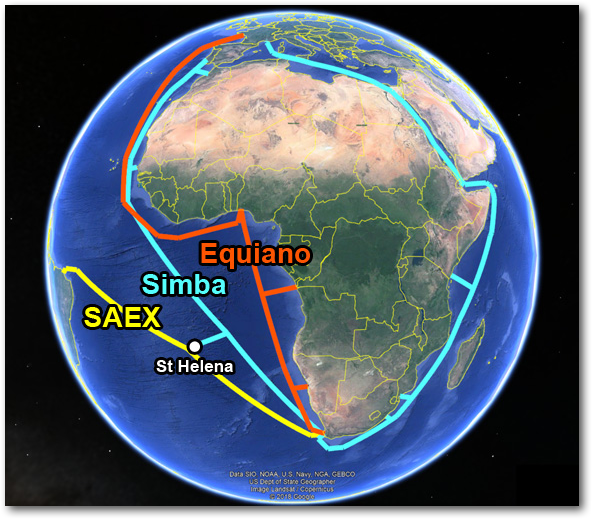
It has always been clear that St Helena cannot afford a dedicated cable to Africa or Latin America as the cost of such would run into the hundreds of millions. The only way to land a fibre optic cable on St Helena would be when another cable runs close to the island from where a short branch to the island could be forked off. Unfortunately, the only other cable project to come close to the island, Seaborn Networks‘ SABR cable (South Africa-Brazil) has not made any progress either, leaving us in desperation. However, with both the SAEX and SABR proposed cable projects finding it difficult to turn ideas into reality, two other proposals for South Atlantic cable routes are emerging.
Last week the Wall Street Journal revealed that two of the world‘s largest Internet companies known for their multi-billion investments in submarine cables, Facebook and Google, are both working on two separate cable systems around the African continent. Facebook‘s “Simba”cable would encircle the African continent while Google‘s “Equiano” cable would be laid off Africa‘s western coast. Large telecom companies like MTN Group and Vodafone are believed to be partners in these cable projects that will connect European and Asian data centres to the growing African telecom markets where more and more people use Facebook‘s and Google‘s services.
This is a long posting so for the full story visit the Connect StHelena website.
See the OpenFalklands post: The St Helena Submarine Cable
[/expand]
![]() [expand title=”St Helena and the Falkland Islands Face Simultaneous Outages. (14-05-19)”]
[expand title=”St Helena and the Falkland Islands Face Simultaneous Outages. (14-05-19)”]
On 30 April 2019, internet service in the Falkland Islands and Saint Helena suffered simultaneous outages.

We often see large outages in islands or remote areas due to limited sources for internet connectivity and/or extreme weather events.
In this case, Sure South Atlantic Ltd is only source of internet connectivity for these two British Overseas Territories. A technical glitch during Sure’s scheduled maintenance extended what was supposed to be an hour of planned downtime into a 4-hour blackout. In his blog, Chris Gare, a former telecoms consultant to the Falklands Government, highlighted another fallout of the blackout in the South Atlantic, namely that the DNS zone for the .fk TLD (which is also run by Sure South Atlantic Ltd) went completely down. It turns out that Sure hosts both NS servers for .fk (ns1.horizon.net.fk = 195.248.193.250, ns2.horizon.net.fk = 195.248.193.251) in the same routed prefix essentially negating the redundancy of multiple NS servers.
The outage also highlights the efforts of Saint Helena to secure a source of high-speed internet other than satellite, which can be expensive, high-latency and capacity constrained. For several years, the “Move This Cable” campaign has advocated for a modification of the route of the proposed SAEx submarine cable. According to its website, “there are over 4,200 people living on one of the most isolated islands in the world” and that landing the SAEx cable in Saint Helena would allow the locals to “finally join the information society, … improve standards of education and healthcare, as well as offering new economic prospects.” After securing a grant of € 21.5 million for the branch from the European Union, funding of the trunk cable across the South Atlantic has become uncertain recently.
Source: Oracle Internet Intelligence
[/expand]
![]() [expand title=”Two updates about overseas SMS texting. (11-05-19)”]
[expand title=”Two updates about overseas SMS texting. (11-05-19)”]
Update 11th May 19
Looking at one or two Sure Falkland Islands monthly bills for April 2019, I see that the SMS texts that were sent to me in the UK as a Vodafone customer have been charged for at the tariff rate of 25 pence even though they were not delivered.
Here is an example of charges without associated refunds.

SMS texts are not a guaranteed reliable service and will not have a “100% success rate” (as stated below in Sure’s Facebook post below), but charges made for non-delivered texts is questionable.
Whether Sure Falkland Islands actually receive non-delivery messages back from receiving mobile network operators in the UK when deliveries fail, depends on the type of SMS Agreement they have with them. If they do, then they should be able to provide refunds.
It seems unusual that Sure South Atlantic (or Sure International or Sure Group) are not centrally managing SMS Agreements on Guernsey and including all of their islands on common AA. 19 Agreements. This would be the most efficient way of managing things and remove the management load of doing this from the small team in Sure Falkland Islands?
If Sure South Atlantic are unable to be confident that overseas SMSs are being delivered then it is questionable that they should be charging for them at all I would have thought? I can’t believe that there are many SMSs being sent these days overseas when there is such widespread use of Internet messaging which is so reliable.
In Europe this is not an issue, as SMS texting is very reliable as can be seen in the example from a Netherlands Mobile Network Operator shows. Over 90% are delivered in less than 5 seconds and a non-delivery rate as low as 4% which were probablt due to customer errors.
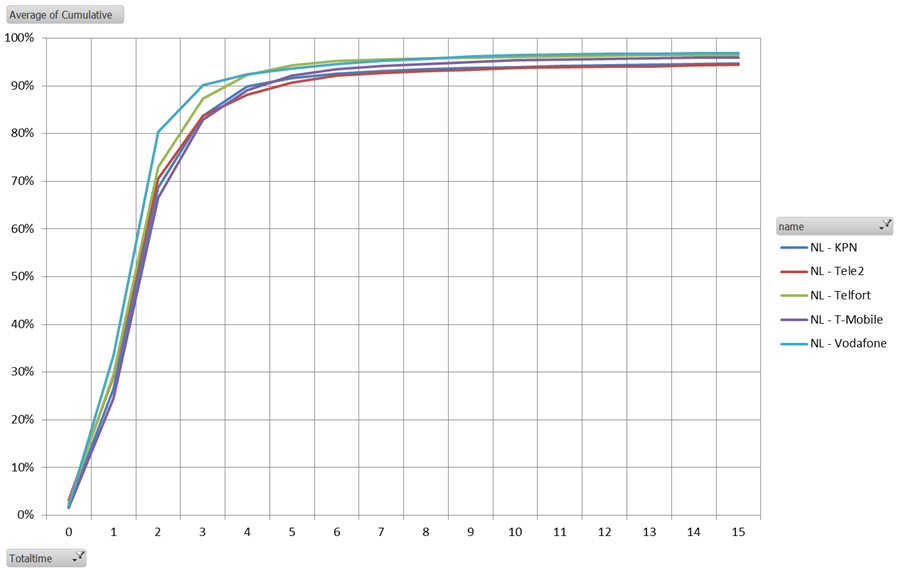
Example SMS delivery errors for an Eu Mobile Nework Operator
Update 7th May 2019


I have talked about SMS text issues with Vodafone and 3 in this post, so I would like to complete this discussion on SMS text delivery by looking at O2 and EE,
There were mixed comments made on Facebook by Sure Falkland Islands’ customers about delivery errors and delivery successes in regard to SMS texts sent to UK O2 and EE customers. My own results, although only few in number, were mixed as well – some worked and some didn’t. I am not able to identify what caused these non-delivery issues and that is why it important that customer help is given to Sure Falklands Islands to investigate this as they propose in their Facebook page below.
Overall, looking at all the four major UK Mobile Network Operators (MNOs), there seems that a lot of work needs to be done to make the service reliable enough to reliably support two-step Verification (2SV).
It’s without doubt that 2SV threw a lifeline to SMS services which was dying on the vine but that is a very important lifeline!
[/expand]
![]() [expand title=”Sure Falkland Islands asks for feedback on SMS text delivery issues – a really positive step forward. (07-05-19)”]
[expand title=”Sure Falkland Islands asks for feedback on SMS text delivery issues – a really positive step forward. (07-05-19)”]
Following the publication of the two OpenFalklands posts concerned with the performance of the Falkland Islands SMS services in the last week –
- Do you have difficulty receiving or sending overseas SMS texts?
- We have just sent a code to your mobile phone Oh damn!
I welcome the positive step taken by Sure Falkland Islands by posting a message on their company’s Face book page and asking their customers to help them identify the issues that are causing the delays and delivery failure of SMS texts.
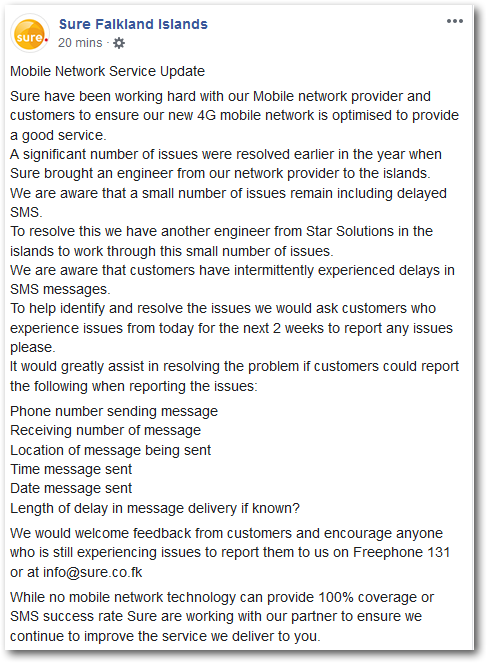 Sure Falkland Island’s recent Facebook post
Sure Falkland Island’s recent Facebook post
I will actively encourage all Sure Falkland Islands’ customers who are are experiencing excessive delays for in-island SMS texts or delivery failure of overseas family and friends to provide Sure Falkland Islands to provide appropriate examples to info@sure.co.fk.
This will help Sure Falkland Islands put the spotlight on the issues in the local network causing the problems and where the lack of appropriate inter-working relationships with overseas mobile network operators hinder delivery of SMS texts.
I would expect local issues could be sorted out quite quickly but the overseas delivery issues will clearly take more time as they involve relationships with 3rd parties.
I really look forward to seeing further posts from Sure Falkland Islands updating their customers as to the state of their progress in this matter.
I would also encourage Sure Falkland Islands to take the opportunity of the strong use of social media on the islands to provide many more updates on the state of the telecommunications services they provide. This could only be seen as a positive step by their customers and businesses alike.
I wish the Sure Falkland Islands engineers success in their activities in coming weeks!
p.s. I look forward to seeing a post concerning .fk DNS mirroring in due course.
[/expand]
![]() [expand title=”Falkland Islands ‘island-wide’ Internet outage this morning. (30-04-19) Updated: (01-05-19 (02-05-19)”]
[expand title=”Falkland Islands ‘island-wide’ Internet outage this morning. (30-04-19) Updated: (01-05-19 (02-05-19)”]
Update (02-05-2019): Intriguing! It looks like the original cause WAS a scheduled planned outage afterall that went wrong – but it was on St Helena! Surely, as the Falkland Islands and St Helena share infrastructure, Sure South Atlantic should have issued a planned outage warning to its Falkland Islands customers?
A glitch during scheduled maintenance works announced for the period from 05:45-06:45 UTC this morning has left St Helena and the Falklands – both suffering under a telecoms monopoly – without international connectivity for a total of 4h 18m today (05:45-05:54 UTC and 05:57-10:06 UTC). The outage, which is blamed on issues at a UK teleport, highlights the lack of sufficient redundancy on the network of the monopolist, Sure South Atlantic Ltd, a wholly owned subsidiary of Batelco Group, as well as the inherent risk of monopolies, namely the total dependency on a single supplier, which is both unacceptable in this time and age where not only the economy hinges on connectivity but in such remote communities people’s health can depend on timely telemedical consultations. Source: LinkedIn
Update (01-05-19): There has been no announcement as to the cause of yesterday’s long island-wide outage by Sure South Atlantic. However, as might be expected from the fact that Internet traffic from the Falklands, Ascension and St Helena are aggregated In the Whitehill earth station in the UK by Sure SA, if the Falkland Islands’ Internet is down caused by “UK equipment” ( not Vodafone’s network in the UK) then the other islands’ Internet could have been down too.
This has proved to be the case in this instance after seeing that St Helena’s Internet was down at the same time as the Falklands. I would assume Ascension was down as well.
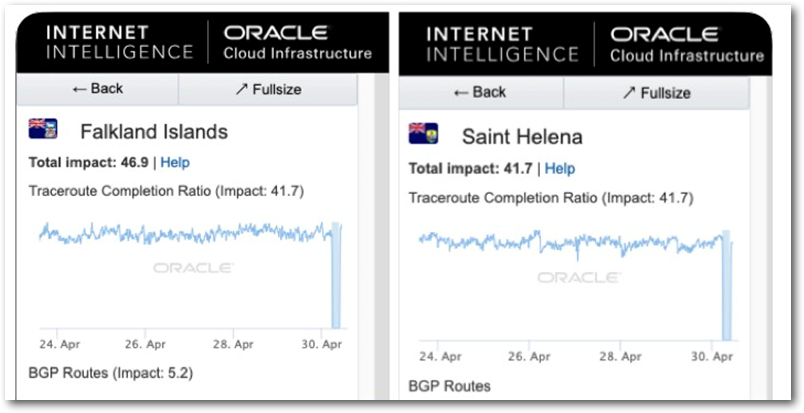
Both the Falkland Islands and St Helena experienced an uplanned outage.
Update (30-04-19): It has been confirmed to me that the Internet was down on the islands this morning from at least 03:00 making the outage at least 4 hours long.
Original post (30-04-19)
When I checked this morning, I could not access any Falkland islands web sites. I am not aware of any ‘Planned Maintenance Outage’ notification being sent out to Sure’s customers (please correct me if I am wrong) so I can only assume that there was an ‘Unplanned Outage’ this morning.
I wanted to know where the problem occurred so I pinged Sure’s 62.208.72.82 router in the UK as a starting point. This is the 1st UK router for Falkland Islands upload traffic and the last UK router for download traffic and all Falkland Islands’ Internet traffic passes through this router / switch.
I found that this router was inaccessible and not responding. Note: I’ve redacted the URLs of my Internet service for privacy reasons.
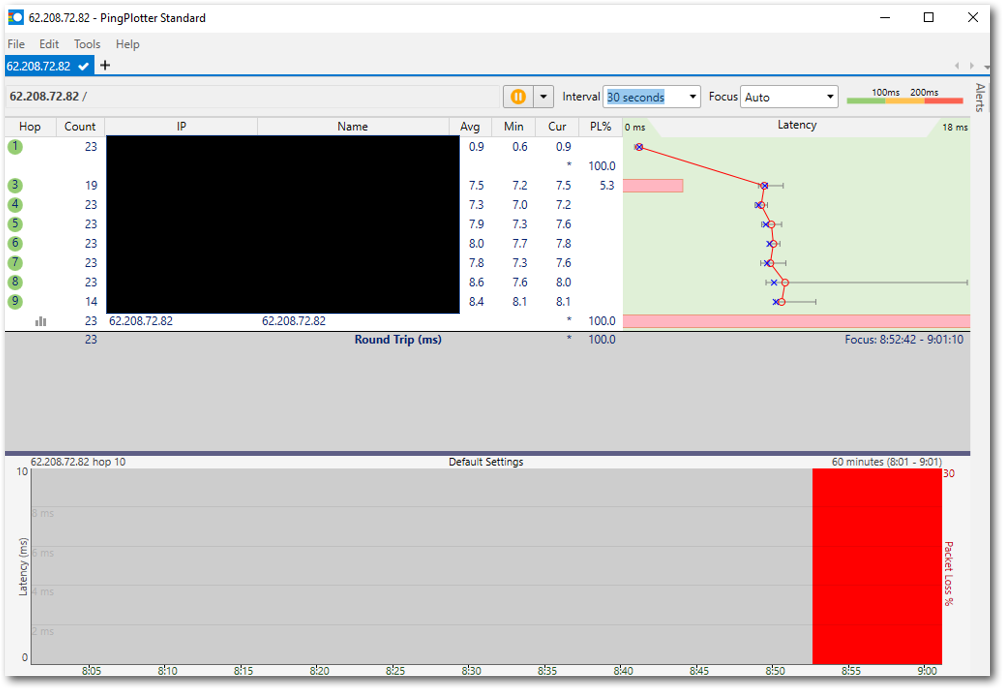
Non-responding Router carrying Falkland Islands Internet traffic
I do not know when the outage started during the night, but the UK router came back on-line at 07:03:11 Falkland Islands time after several hours as can be seen in the picture below. Accessibility to Falkland Islands’ web sites started immediately.
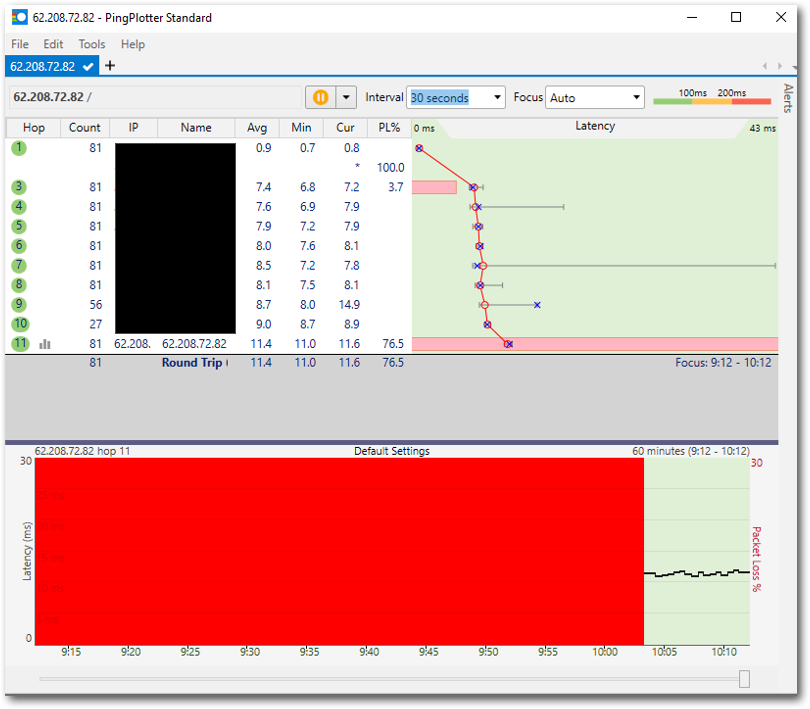
Router carrying Falkland Islands Internet traffic back on-line at 07:03:11
I would assume that because it was Sure SA managed UK equipment that had an issue, that the Internet was completely inaccessible by Falkland Islands customers during the multi-hour outage. I’m happy to be corrected if I have this wrong.
This event shows how important a number of issues are. Multi-homing and resilience for one and independent monitoring for a second. I would hope that Sure SA make a public announcement explaining what the cause of the issue was and that the Regulator follows through with enquiries to make sure that Sure SA implements process changes to ensure this does not re-occur.
[/expand]
![]() [expand title=”Intelsat-29e declared a total loss. (19-04-19)(Update: 24-04-19)”]
[expand title=”Intelsat-29e declared a total loss. (19-04-19)(Update: 24-04-19)”]
Intelsat-29e suffered a fuel leak April 7 after just three years in geostationary orbit. Most geostationary communications satellites last 15 years if not longer.
After the fuel leak, a subsequent problem arose with Intelsat-29e’s communications link, causing gaps in contact with the satellite. Commercial telescopes from ExoAnalytic Solutions spotted the satellite drifting from its orbital position April 8.
In an April 18 statement, Intelsat it formed a failure review board with Boeing, the satellite’s manufacturer, to conduct a “comprehensive analysis of the cause of the anomaly.”
Intelsat has six Epic-class high-throughput satellites in orbit, of which Boeing built payloads for all and the chassis for five (Airbus supplied the platform for Intelsat-32e).
Intelsat said the majority of customers on Intelsat-29e have been transferred to other satellites in its fleet of around 50 spacecraft or onto satellites from other operators. Intelsat-29e covered the Americas and surrounding regions, including the Caribbean and the North Atlantic. It carried transponders in C-, Ku- and Ka-band frequencies.
Source: SpaceNews
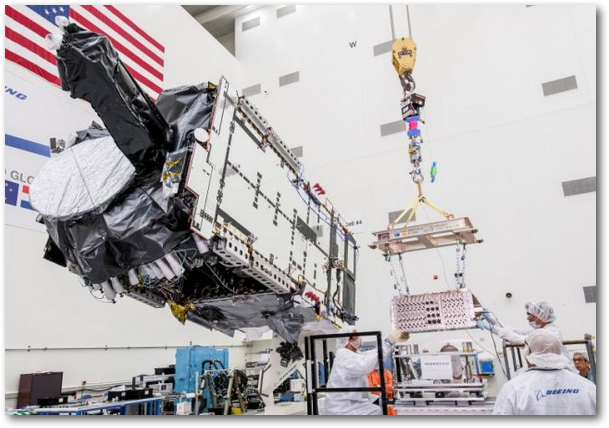 The IS-29e before its launch. Source: Space.com
The IS-29e before its launch. Source: Space.com
The satellite was 14,445 pounds (6,552 kilograms) at launch and measured about 24.6 by 9.8 by 6.6 feet (7.5 by 3 by 2 meters). It’s two solar panels produced about 15.8 kilowatts of power. It was designed to last at least 15 years in orbit.
Update: 20-04-2019
Given that Intelsat has declared its IS-29E a total loss, “means it will continue to drift uncontrolled along its current orbit in GEO,” explains T.S. Kelso, the operator of CelesTrak, a leading source for orbital element sets and related software to keep an eye on satellites and orbital debris.
Kelso tweeted back on April 16th that the current situation with IS-29E “continues to be quite troubling,” with the troubled satellite spiraling around IS-11 & IS-32E. Additionally there are reports of 13 pieces of associated debris, he reported.
(CG: Fortunately the IS-37e, the one on the right, is a good distance away from the IS-29e.)
Source: Leonard David’s Inside Outer Space
Update: 24-04-2019
Intelsat IS-29e dead, but still dangerous
The challenge now is that IS-29e is spinning out of control, and in an increasingly elliptical orbit which could pose problems to other satellites in the geostationary arc. Observations made by ExoAnalytic Solutions showed the propellant leaking into space, and also indicated the craft possibly breaking up.
The satellite is also moving slightly faster than nominal and is ‘overtaking’ other satellites in its path. Ground-based technicians controlling other satellites in the path of IS-29 are able to compensate for any possible risk by slightly raising or lowering the orbits of their satellites and thus avoiding collision. Intelsat itself is very closely monitoring the precise path and location of IS-29 and will be alerting other operators of any threat.
Source: Advanced Television
OpenFalklands’ comment: It has been confirmed to me by an industry colleague that Sure SA were not using this satellite and are using the Intelsat IS-37e satellite which is good to hear!
The Intelsat Epic satellites were discussed in my post Falkland Islands’ satellite – spoilt for choice! Part 1, Intelsat EPIC.
[/expand]
![]() [expand title=”Arianespace completed SES’s first-generation O3b constellation. (04-04-19)”]
[expand title=”Arianespace completed SES’s first-generation O3b constellation. (04-04-19)”]
The rocket lifted off at 1:04 p.m. Eastern from Europe’s Guiana Space Centre near Kourou, French Guiana.
The 700-kilogram satellites, designed for broadband connectivity services, separated from the Russian-built rocket two at a time, the first set two hours and one minute after liftoff and the second set 22 minutes later.
SES now has 20 O3b satellites in medium Earth orbit. Franco-Italian manufacturer Thales Alenia Space built the Ka-band satellites, each of which carries 20 gigabits per second of throughput.
Luxembourg-based SES operates the O3b satellites 8,000 kilometers above the Earth — about a fourth the distance of geostationary orbit where most telecom satellites reside. The proximity of the O3b satellites means less lag time for communications services.
SES spokesperson Suzanne Ong said the four new satellites increase the throughput of the O3b constellation by 26 percent. The O3b constellation’s coverage area remains largely the same, she said, fanning out 50 degrees north and south of the equator.
Since then, multiple companies have started placing broadband satellites in low Earth orbit even closer to the Earth. SpaceX and Telesat have prototype spacecraft, and OneWeb has six operational satellites, all in low Earth orbit.
John-Paul Hemingway, SES Networks CEO, stood by SES’s decision to focus on medium Earth orbit, arguing that low Earth orbit systems will face latency challenges similar to GEO satellites because their closer proximity to the Earth means smaller coverage areas, necessitating routing traffic through multiple stops for long-distance communications.
“If you want to get from Africa to London, you’ve got to get through multiple hops to get there, so ultimately the delay will be the same [as a higher orbit],” he said. “We really think this medium Earth orbit is the sweet spot.”
Not all operators agree with that assessment. LeoSat, which is preparing a constellation of 108 low Earth orbit satellites equipped with intersatellite links, says it will be faster than fiber for some long distance communications.
Hemingway said SES can route latency-sensitive traffic, such as video conferencing, over O3b satellites, and route other traffic like web browsing over its 50-plus geostationary satellites.
Hemingway said the influx of investment into constellations of small satellites, as well as other satellite systems, is proof that satellite communications is becoming mainstream rather than a solution of last resort.
“It has to be used with fiber, with microwave, and satellite will be mainstream,” he said. “All of this is proof for me that it’s happening.”
SES has seven second-generation O3b satellites under construction with Boeing, designed to collectively provide 10 terabits per second of capacity. SES has not selected a launch provider, but plans to have the second generation, known as O3b mPower, in orbit in 2021.
Source: SpaceNews
[/expand]
![]() [expand title=”UK Broadband speeds must be revealed to customers. (28-02-19)” ]
[expand title=”UK Broadband speeds must be revealed to customers. (28-02-19)” ]
It is part of regulator Ofcom’s pledge to make broadband contracts more “clear and honest”.
If broadband speed drops below the promised level, firms have one month to improve performance or let customers cancel the contract with no penalty. Consumer groups applauded the changes. Richard Neudegg, head of regulation at price comparison site uSwitch, said: “This should be welcome news for any customers blighted by the frustrations of relentlessly buffering broadband.
“This new code also improves the property-specific information about speeds that broadband providers have to give before you sign up. “This is welcome, but providers should go further in opening up this information so that consumers are able to make side-by-side comparisons between providers, so that they can make the best choice.”
Under the new rules, broadband firms must also reveal what speeds customers can expect at busy times – typically evenings for home users – when more people are using the network.
Lindsey Fussell, Ofcom’s consumer group director, said: “When you sign a contract, you should be treated fairly and know exactly what you’re getting.
“These protections mean broadband shoppers can buy with confidence. Before they sign up, customers will be told their minimum internet speed. And if companies break that promise, they’ll have to sort it out quickly, or let the customer walk away.”
Upgrade incentive
Ofcom is at the centre of a campaign to persuade users to upgrade to faster broadband as well as reviewing broadband firms’ pricing practices and ensuring customers get the best available deals.
According to the regulator’s research, those with a basic broadband connection have less than a one-in-five chance of being able to stream Netflix in ultra-high definition.
Matthew Howett, founder of research firm Assembly, said the new code could act “as an incentive for broadband providers to move customers on to full-fibre connections, since speeds in the fibre network are easier to guarantee and less susceptible to network congestion”.
As part of its work – dubbed Fairness for Customers – Ofcom is also reviewing how mobile operators charge their customers for handsets when bundled with airtime.
Source: BBC News
[/expand]
![]() [expand title=”Brexit preparedness: Removal of Galileo back-up sites from UK territory continue. (26-02-19)”]
[expand title=”Brexit preparedness: Removal of Galileo back-up sites from UK territory continue. (26-02-19)”]
As part of its Brexit preparedness work, the Commission is taking the necessary operational steps to ensure business continuity and preserve the security of the Galileo satellite navigation system after the withdrawal of the United Kingdom from the European Union. The Galileo back-up sites located in the United Kingdom’s territory are being transferred to the EU. Following a Commission decision in January 2018, the Galileo Security Monitoring Centre (GSMC) back-up site has been moved to Spain. Now the two Galileo Sensor Stations located on the Falkland and Ascension Islands are being removed. The Galileo sensor stations located on the Ascension and Falkland Islands host cryptographic material/EU classified information, which in accordance with the EU security rules is not allowed to be located in the territory of third countries, unless relevant agreements are in place. Today the Commission has amended the relevant legal act determining the location of the ground-based infrastructure of the system established under the Galileo programme and setting out the necessary measures to ensure that it functions smoothly. The removal of these two stations does not affect the overall performance of Galileo services, which remains excellent, as there is sufficient capacity in the system. Galileo, the EU’s global satellite navigation system, has been providing positioning and timing services to around 600 million users since December 2016. The number of users continues to grow and Galileo provides an increasingly precise signal across a range of valuable services.
[/expand]
Chris Gare, 2019 Copyright: OpenFalklands.com



One Reply to “News: St Helena Communications Licence Market Engagement”